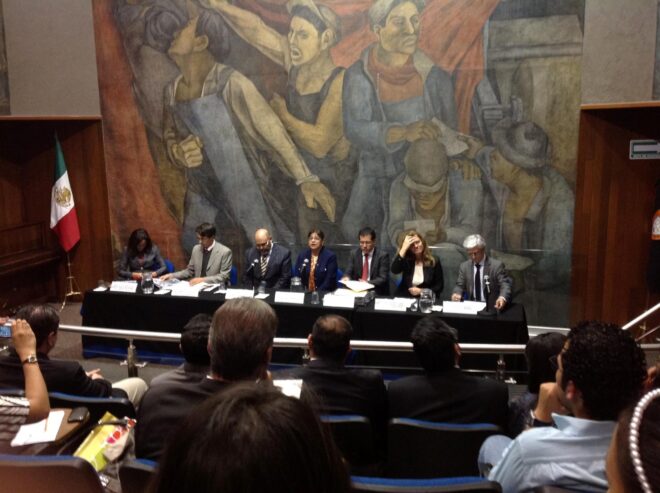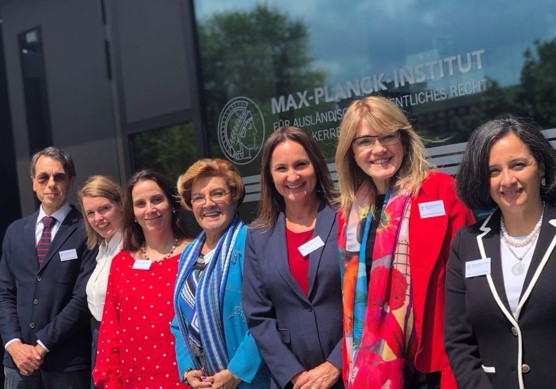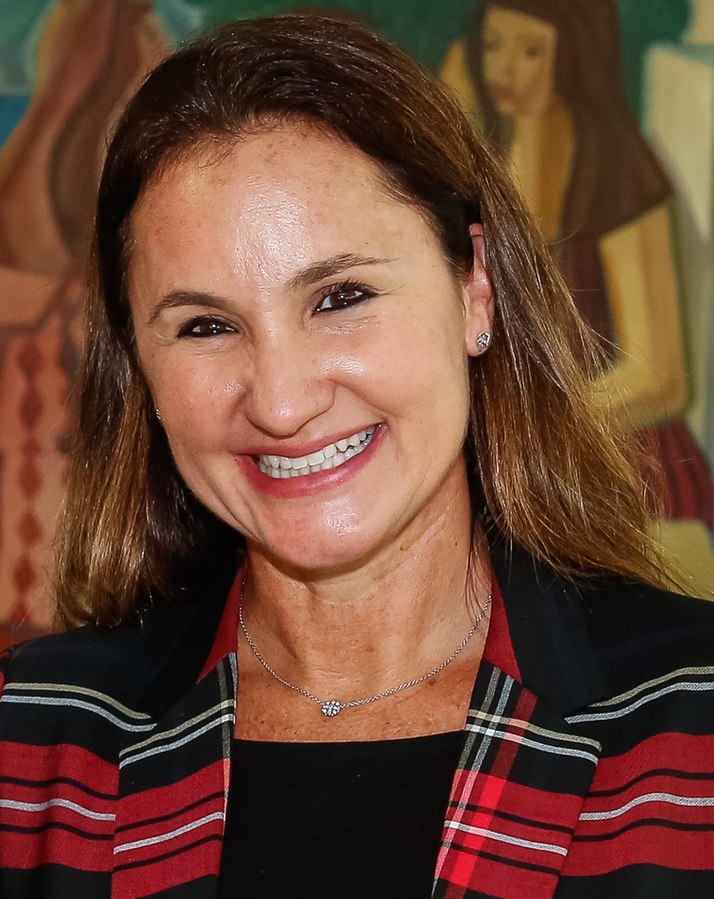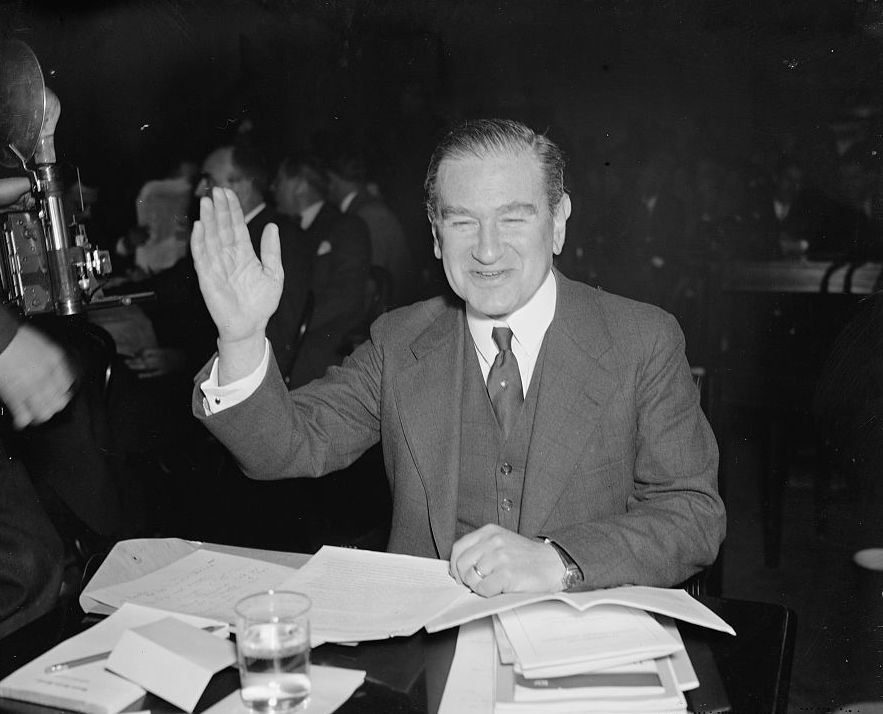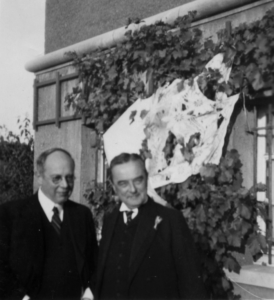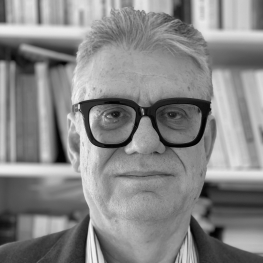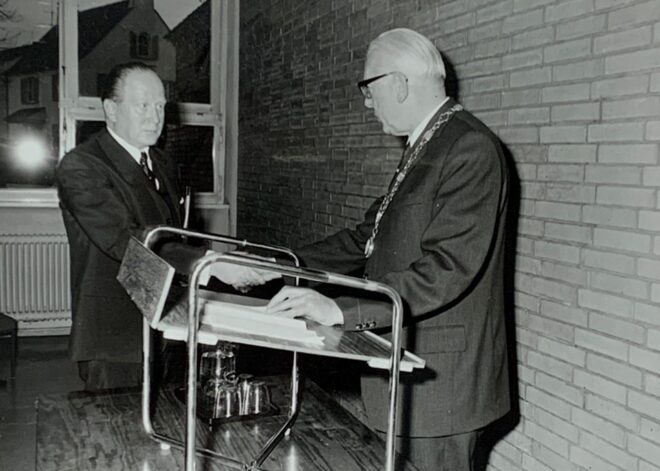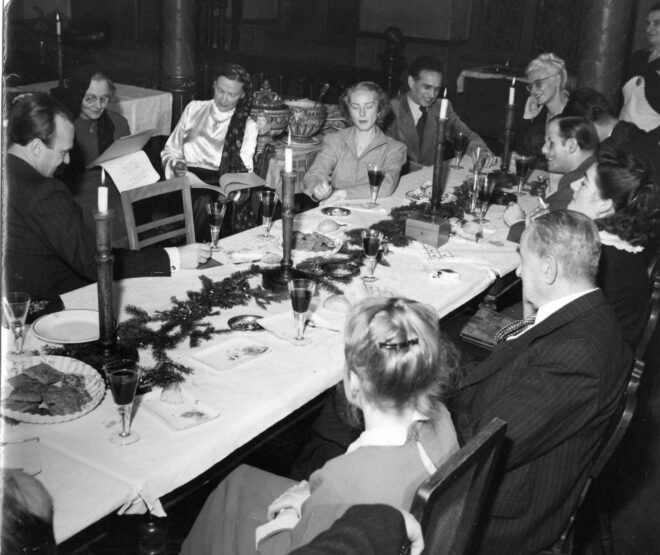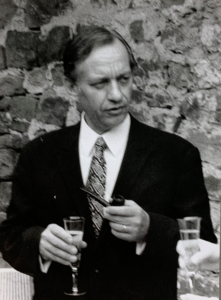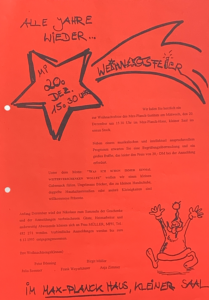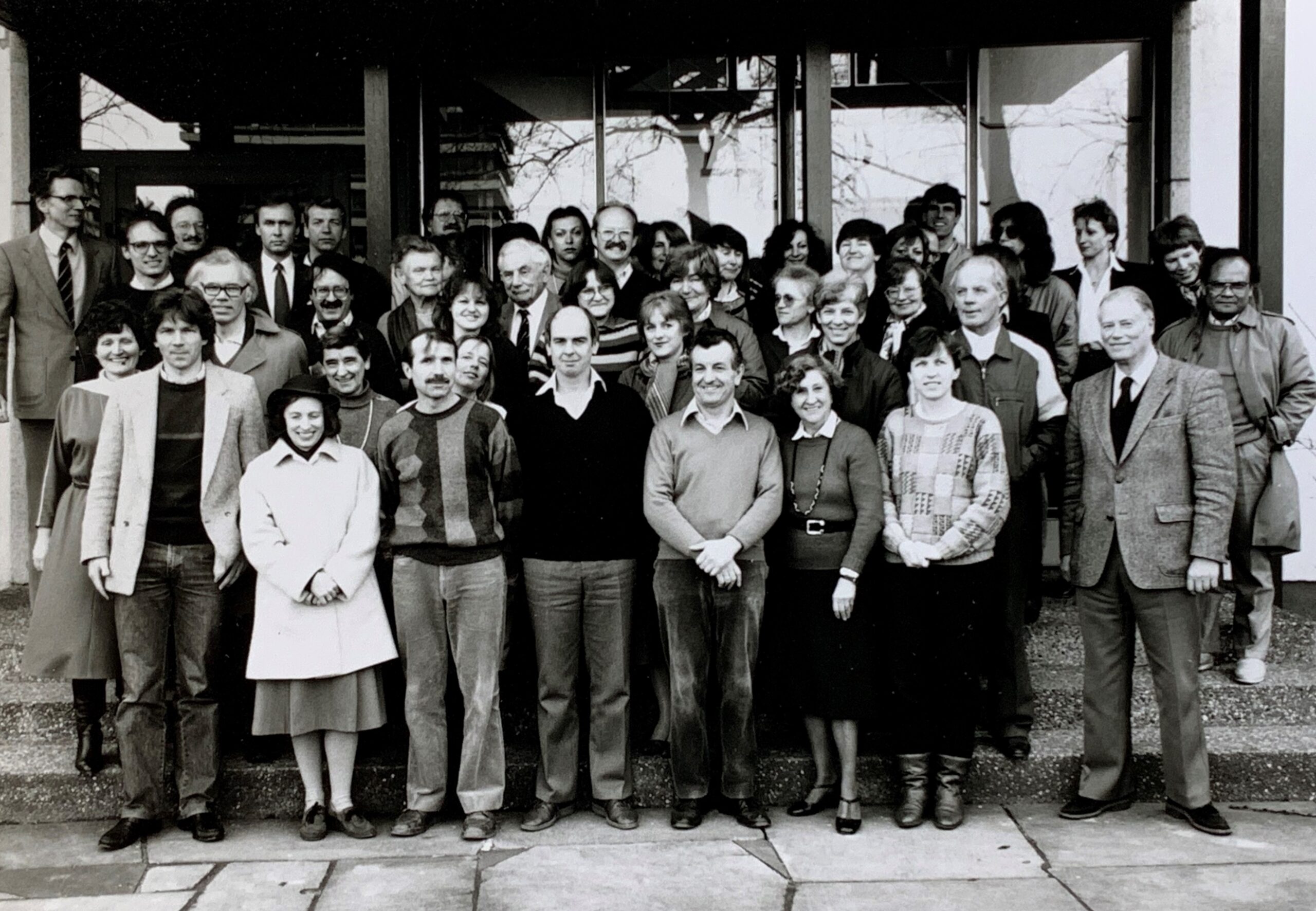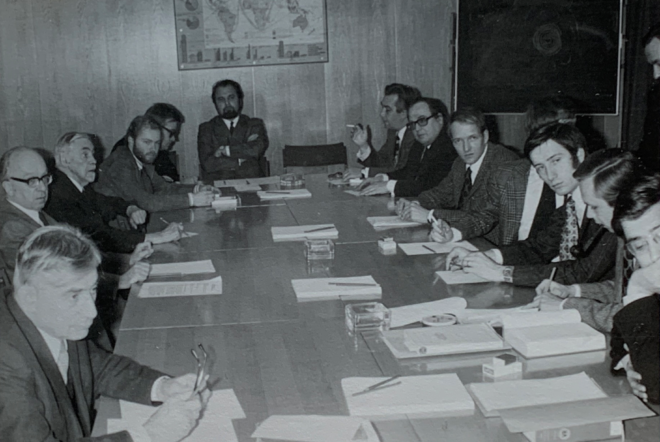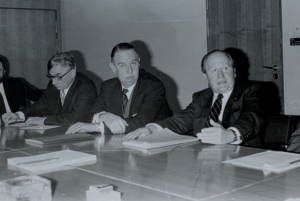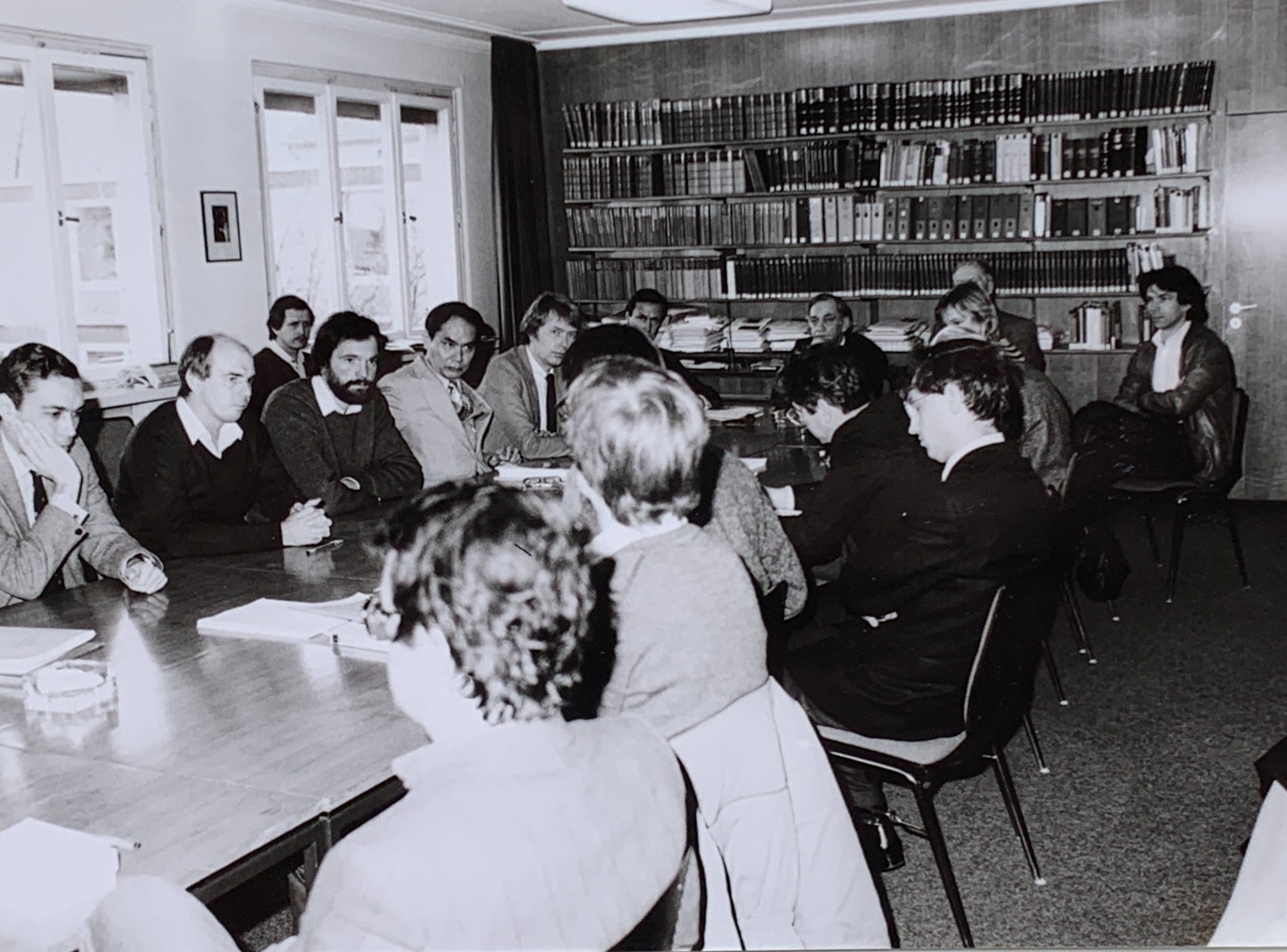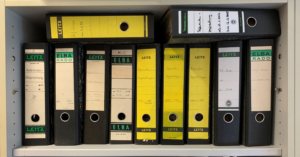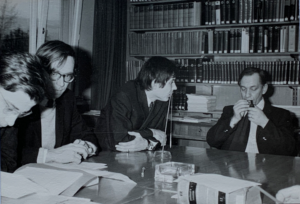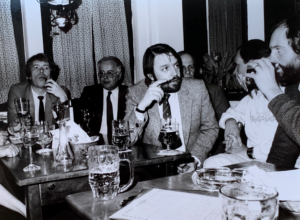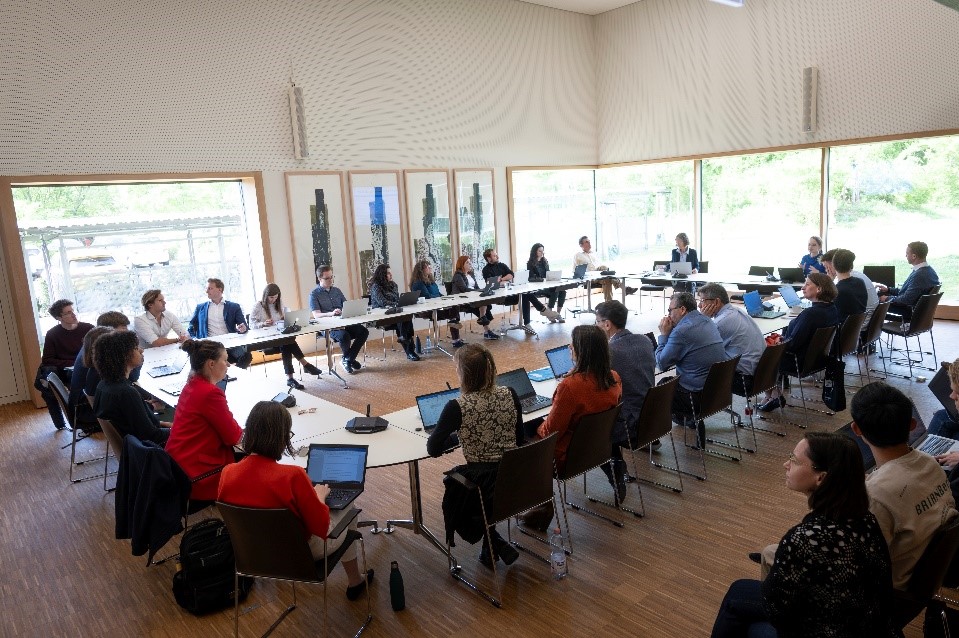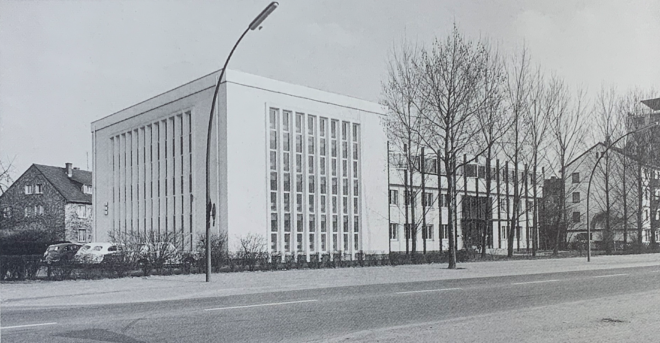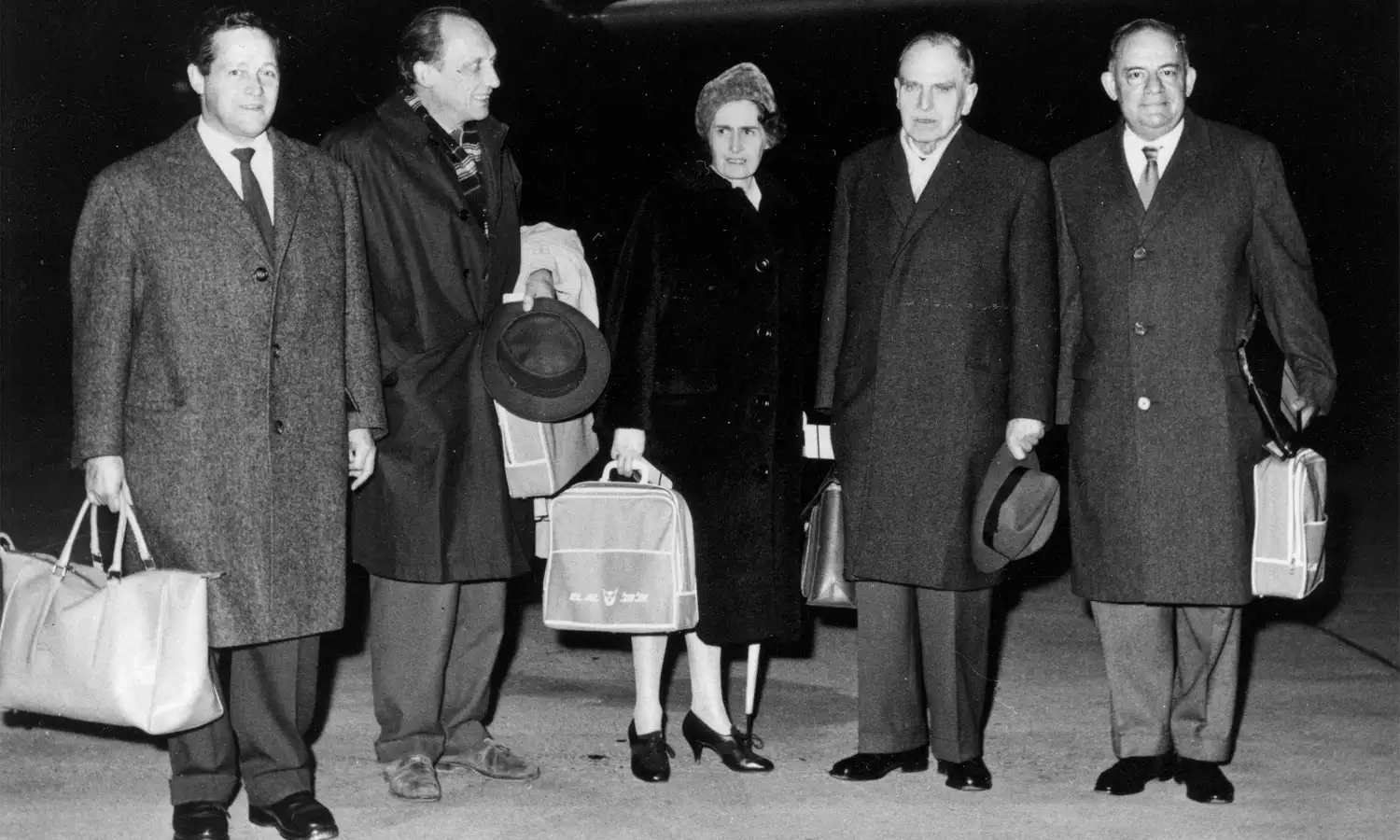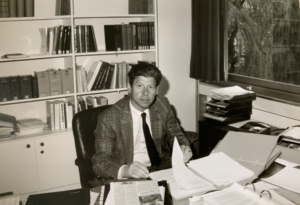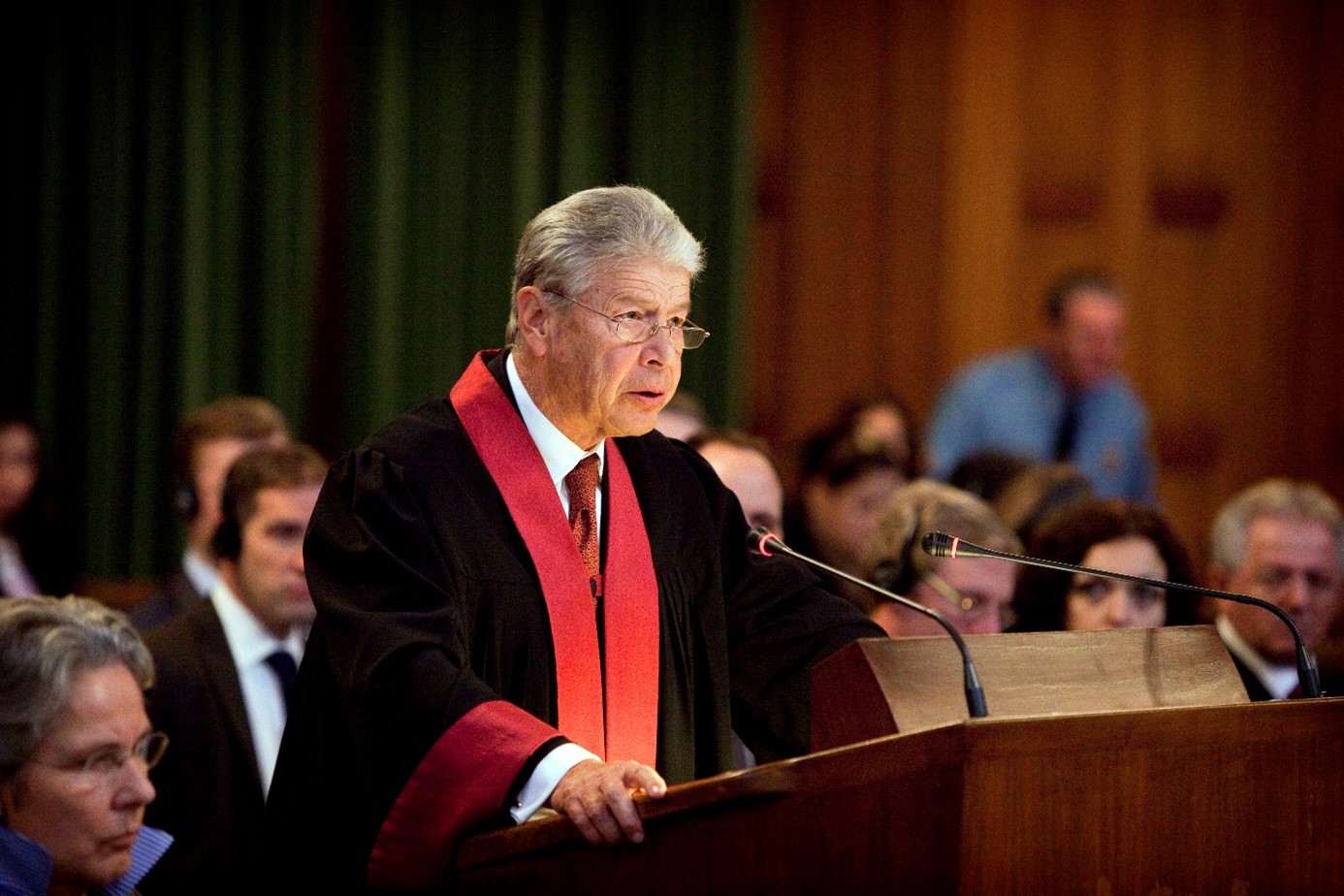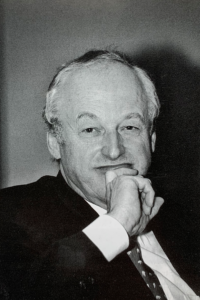In der schier unerschöpflichen Sammlung der Bibliothek des Max-Planck-Instituts für ausländisches öffentliches Recht und Völkerrecht findet sich unter der Signatur „VR: XVII H: 40“ ein unscheinbares Büchlein von etwa 200 getippten Seiten, teilweise mit handschriftlichen Korrekturen und Ergänzungen. „Sollte man nicht das Manuskript wegen seines historischen Interesses einbinden und in die Bibliothek geben?“ hat Institutsdirektor Jochen Frowein in einem Begleitschreiben aus dem Jahre 1987 angemerkt und somit der Nachwelt ein einmaliges Zeitdokument erhalten.
Hinter „VR: XVII H: 40“ verbirgt sich das Manuskript einer einstündigen Vorlesung zum Kriegsrecht, die Ernst Schmitz, (1895-1942) im Sommersemester 1938 in zehn Terminen an der Universität zu Berlin gehalten hat. Schmitz, selbst vielfach verwundeter Weltkriegs-Veteran, war 1926 in das Kaiser-Wilhelm-Institut für ausländisches öffentliches Recht und Völkerrecht eingetreten und wurde 1934 dessen stellvertretender Direktor. „Es handelt sich um eine sehr klare Darstellung der Materie am Vorabend des 2. Weltkrieges“ schrieb Hermann Mosler, der das Manuskript 1987 in seinem Heidelberger Büroschrank entdeckte. Nachfolgend möchte ich insbesondere drei Punkte hervorheben: die methodischen Herausforderungen der Analyse einer Kriegsrechtsvorlesung aus dem Jahre 1938 (I.), das darin enthaltene Völkerrechtsverständnis (II.) und schließlich Aussagen zum kriegsrechtlichen Humanitätsprinzip (III.).
I. Der blinde Fleck
Bei der Bewertung geschichtlicher Entwicklungen ist der menschliche Verstand aufgrund seiner kognitiven Strukturiertheit besonders anfällig für den hindsight bias bzw. Rückschaufehler.[1] Insbesondere die sog. Cambridge School mahnt stattdessen zur Kontextualisierung und zeitlichen Verortung der Dokumente, zur Vergegenwärtigung der Kontingenz geschichtlicher Entwicklung.[2] Und doch: Es fällt schwer, bei der Lektüre des Vorlesungsskripts nicht an den 1. September 1939 zu denken – auszublenden, dass Friedrich Hoßbach bereits am 10. November 1937 sein berühmtes „Protokoll“ niedergeschrieben hatte, das als zentrales Beweismittel für Verbrechen gegen den Frieden (Planen, Vorbereitung und Einleitung oder Durchführung eines Angriffskrieges oder eines Krieges unter Verletzung internationaler Verträge) nach Artikel 6 a des Statuts für den Internationalen Militärgerichtshof vom 8. August 1945 diente. „Zur Lösung der deutschen Frage könne es nur den Weg der Gewalt geben“ heißt es dort. Es bleibe einzig „die Beantwortung der Fragen ‚wann‘ und ‚wie‘.“[3] Völkerrechtler*innen denken zwangsläufig an die griechische Ortschaft Distomo und den sogenannten „Sühnebefehl“ des Oberkommandos der Wehrmacht vom Herbst 1941: „Als Sühne für ein deutsches Soldatenleben muß in diesen Fällen im allgemeinen die Todesstrafe für 50-100 Kommunisten als angemessen gelten. Die Art der Vollstreckung muß die abschreckende Wirkung noch erhöhen.“[4] Schmitz’ „Gedanke an den möglichen Ausbruch eines Krieges in nicht allzuferner Zukunft“ (S. 53b) erscheint hierbei – in Anerkennung des Rückschaufehlers – wie ein Menetekel.
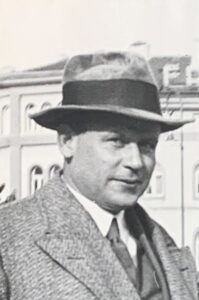
Ernst Martin Schmitz, undatiert[5]
Vor diesem Hintergrund wirkt das Manuskript überraschend sachlich, jedenfalls im Vergleich mit anderen Publikationen aus dieser Zeit, etwa solchen der „Deutschen Gesellschaft für Wehrpolitik und Wehrwissenschaften“, in welcher Schmitz sich ebenfalls engagierte. Freilich, man merkt dem Manuskript sein Entstehungsjahr an: Auf Seite 12 etwa wird von der „nationalsozialistischen Auffassung von Staat und Volk“ gesprochen. Diese habe zur Folge, dass – entgegen des Rousseau’schen Diktums – „der Krieg nicht nur die Staaten zu Feinden macht, sondern auch alle Personen, aus denen sie sich zusammensetzen“ (S. 10). Nach Schmitz ergebe sich daraus allerdings „nicht, dass alle diese Feinde rechtmässig in der gleichen Weise behandelt werden dürfen“ (S. 13). Ein ähnliches Muster findet sich an anderer Stelle, wo Schmitz von den Kriegen der Zukunft und neuen Waffen, insbesondere der Luftwaffe spricht: „Die Wirkungen des Luftkrieges, das ist richtig, können nicht auf die Angehörigen der Armee beschränkt werden; sie müssen auch die Zivilbevölkerung treffen“ (S. 35). Dennoch ist er kein Anhänger der Lehre des totalen Luftkrieges, wie sie der italienische General Giulio Douhet entwickelt hat (Il domino dell’aria, 1921).[6] Die Kritik wird freilich nur angedeutet: „Gegen diese in ihrer Ausdehnung fast unübersehbaren Möglichkeiten sind auch von militärischer Seite Bedenken erhoben worden wie denn überhaupt die Lehre von Douhet zum Teil sehr scharfe Kritik in Fachkreisen gefunden hat“ (S. 35). Man dürfe daher „nicht den Schluss ziehen, dass […] der Unterschied zwischen den Angehörigen der bewaffneten Macht und der Zivilbevölkerung in jeder Beziehung verschwinden müsse“ (S. 35). Dem Einsatz der Luftwaffe zur Brechung der „moralische[n] Widerstandskraft der Bevölkerung […], wenn diese nämlich planmäßig durch Luftangriffe terrorisiert werde“ (S. 35), erteilt er keine klare Absage. Er weist lediglich in utilitaristisch anmutender Weise darauf hin, dass die „Luftwaffe […] zu kostbar [ist], als dass man sie gegen andere als militärisch wichtige Objekte einsetzen könnte.“ Außerdem sei die „Terrorwirkung von Angriffen auf die Zivilbevölkerung […] örtlich beschränkbar, da eine scharfe Pressezensur die Verbreitung der Nachrichten von erfolgreichen Luftbombardements bis zu einem gewissen Grade verhindern kann“ (S. 35). Die Terrorisierung der Zivilbevölkerung aus der Luft erscheint hierdurch militärisch schlicht nicht notwendig. Von humanitären Erwägungen oder kriegsrechtlicher Unzulässigkeit dagegen findet sich kein Wort, doch dazu später mehr.
Der „aggressiv-imperiale Kurs“ des NS-Regimes, auf den das Institut und führende Exponenten desselben sich begeben hatten, ist auffällig abwesend. Es gibt keinerlei Anklänge einer „rassentheoretisch begründete[n] […] Verwandlung des Völkerrechts“ und seiner biologistischen Rekonstruktion.[7] Es fehlt überhaupt an der dem Denken der geistig-politischen Epoche gemäßen Sprache.[8] Schmitz’ Vorlesung ist weiterhin in der Sprache des traditionellen Völkerrechts abgefasst. Auch der verschiedentlich verwendete Begriff der (Staaten-)Gemeinschaft erscheint nicht nationalsozialistisch aufgeladen,[9] wie es etwa in Günther Küchenhoffs Abhandlung „Nationaler Gemeinschaftsstaat, Volksrecht und Volksrechtsprechung“ bereits 1934 der Fall war. Schmitz spricht auch an keiner Stelle von einer „Großraumordnung“, die bereits denknotwendig nicht ohne Krieg erschaffen werden kann. Im Gegenteil scheint er am ius ad bellum weiterhin festzuhalten, das Küchenhoff – freilich 1944 – durch ein „völkische[s] Führungsverhältnis […] bei der Neuordnung Europas“ ersetzen wollte.[10]
Abwesend sind aber nicht nur nationalsozialistische Topoi, sondern Polemisierungen generell. An keiner Stelle wird der Versailler Vertrag mit den, damals auch im akademischen Sprachgebrauch üblichen, Verunglimpfungen versehen, gegen den Völkerbund gehetzt, andere Staaten diskreditiert oder die „Deutschlandfeindlichkeit“ des Völkerrechts seit dem Untergang des Heiligen Römischen Reiches gerügt.[11] Ebenfalls abwesend ist Carl Schmitts in „Der Begriff des Politischen“ (1927/1932) entwickelte Freund-Feind-Unterscheidung. An Möglichkeiten hierzu hätte es nicht gemangelt, etwa bei den Ausführungen zur Frage „Was ist Krieg?“ (S. 7 ff.). Hier stützt sich Schmitz, wie auch noch verschiedentlich später in der Vorlesung, auf Carl von Clausewitz’ „vielzitierte[…]und wenig gelesene[…]“ Schrift „Vom Kriege“, die wie Ciceros „inter arma enim silent leges“ bis heute in jeder kriegsrechtlichen Abhandlung wohl mindestens einmal Erwähnung findet. Schmitz ist sich der Stimmen bewusst, die den totalen Krieg als den Krieg der Zukunft erwarten: „total, was die Kräfte anlangt, die eingesetzt werden, um das Kriegsziel zu erreichen, total, was die Objekte angeht, gegen die sich die Kriegshandlungen richten und total, was die Mittel der Kriegführung betrifft“ (S. 33 f.). Möglicherweise findet sich hier sogar eine wohlverborgene Kritik: Clausewitz’ Diktum vom Krieg „als eine Fortsetzung des politischen Verkehrs mit Einmischung anderer Mittel“ sollte man sich nach Schmitz „gerade heute vor Augen halten, wo allgemein die Neigung besteht, den Krieg der Zukunft als reinen Ausrottungskrieg aufzufassen und die restlose Vernichtung des Gegners als das eigentliche Ziel des Krieges anzusehen, als einen Zustand, der sämtliche Beziehungen zerreisst und zwischen den Kriegführenden einen Zustand absoluter Rechtlosigkeit herbeiführt“ (S. 33). Vor diesem Hintergrund ist Schmitz’ Definition des Krieges als „nur eine vorübergehende Störung der internationalen Ordnung“, nicht deren Aufhebung (S. 32), umso beachtlicher. Denn „[f]ür keinen wäre es möglich, sich durch das Chaos eines solchen Krieges als geordnetes Staatswesen hindurchzuretten“ (S. 33). Hieraus ergibt sich auch die Aufgabe des Kriegsrechts:
„die Ausübung der Gewalt in solchen Formen zu verhindern, die zur Erreichung des Kriegszwecks nicht notwendig sind, sondern nur geeignet, die Kluft zwischen den Kriegführenden zu verbreitern und Hass und Rachegefühle zu wecken und zu erhalten, die auch nach dem Kriegsende fortwirken, ein Gemeinschaftsgefühl zwischen den Völkern nicht aufkommen lassen und so einen wirklichen Friedenszustand verhindern, der den Krieg ablöst“ (S. 31 f.).
Dies zeigt die jedenfalls indirekte Verschränkung des ius in bello mit dem ius ad bellum. Zu letzterem schreibt Schmitz leider bedauerlich wenig, woraus für die Positionierung seines Kriegsrechtsverständnis wichtige Rückschlüsse hätten gezogen werden können. Fußnoten setzt Schmitz ebenfalls nur spärlich. So aber bleibt ungesagt, was der Rheinländer Schmitz, der von Maria Bruns für sein „Herz und Charakter“ sowie „joviales Wesen“ sehr geschätzt wurde, unter einem „wirklichen Friedenszustand“ versteht. Sicherlich: Ein „Pazifist“, wie etwa die Mitglieder der Gruppe um Walter Schücking und Hans Wehberg, war Schmitz nicht, dafür nimmt er den Krieg zu selbstverständlich als unvermeidbar hin. Aus dem Vorlesungsmanuskript geht aber nicht hervor, dass er den Krieg als „Fundamentalinstitution des Staates“ verherrlicht.[12]
Überhaupt enthält Schmitz‘ Vorlesung keinen theoretischen Unterbau. Nach der maßgeblich unter dem Einfluss von Karl August Eckhardt im Sinne der „nationalsozialistischen Rechtserneuerung“[13] umgestalteten juristischen Studienordnung von 1935 wäre dies eigentlich erforderlich gewesen.[14] Denn in den vorangestellten „Grundgedanken“ der Studienordnung heißt es: „Die deutsche Rechtswissenschaft muß nationalsozialistisch werden. Nationalsozialismus ist kein Lippenbekenntnis, sondern eine Weltanschauung. […] Im geistigen Ringen um neue Werte gibt es keinen besseren Kampfplatz als die Universität.“[15] Sozialdarwinistische Deutungen des Krieges, die sich vor dem Hintergrund der nationalsozialistischen „rassegesetzlichen Rechtslehre“ angeboten hätten, bleiben aus.[16] Dass Schmitz aus dem Kriegsrecht keinen „nationalsozialistischen Kampfplatz“ macht und nicht von „völkischen Grundlagen der [Völkerrechts]Wissenschaft“ sprach,[17] ist vor diesem Hintergrund durchaus eine Botschaft.
II. Kriegsrecht und Völkerrechtsordnung
Krieg sei „nur ein Teil des politischen Verkehrs“, wie Schmitz unter Bezugnahme auf Clausewitz’ berühmte Beschreibung des Kriegs „als eine Fortsetzung des politischen Verkehrs mit Einmischung anderer Mittel“ betont (S. 32). Andernfalls bedeutete Krieg Chaos. Ein Chaos, „das herbeizuführen aber eben nicht das Ziel der Politik sein kann; denn es liegt im wohlverstandenen eigenen Interesse eines jeden Staates, der sich nicht selbst aufgeben will, seine Politik auf die Wiederherstellung der internationalen Ordnung zu richten“ (S. 33). Das Kriegsrecht erscheint damit nicht nur als Teil des Völkerrechts – „wenn dies überhaupt gesagt werden muss“ (S. 1) –, sondern gewissermaßen als dessen Notordnung. Diese Selbstverständlichkeit wäre nicht weiter zu erwähnen, ließe sie nicht wertvolle Rückschlüsse auf das allgemeine Völkerrechtsverständnis zu. „Man darf nicht vergessen“, schreibt er auf Seite 41, „dass ja im wesentlichen die Grossmächte die Einhaltung des Völkerrechts garantieren, d.h. durch ihr Zusammenwirken für seine Beobachtung sorgen.“ Dieses „Großmächtevölkerrecht“ mit all seiner Dysfunktionalität entspringt der Tradition des europäischen Mächtekonzerts des 19. Jahrhunderts. Ist dieses aber gespalten, wie etwa politisch-sachlich im Krimkrieg oder politisch-emotional im Ersten Weltkrieg, bedeute dies „eine Erschütterung der Wirksamkeit der Völkerrechtsordnung“ (S. 41). Erst dann erscheine Krieg als bedrohlicher Ausnahmezustand. Ähnlich der Denkweise Otto von Bismarcks sieht Schmitz das größte Übel in der Verallgemeinerung des Krieges, bedeute dies doch „eine gewisse Gefahr für die Einhaltung der Normen des Kriegsrechts“ (S. 41). Diese Verallgemeinerung sei aber „notwendige Folge der Durchführung der kollektiven Sicherheit“, wie sie etwa die Völkerbundsatzung vorsehe. Schmitz steht diesem Mechanismus der Friedenssicherung ablehnend gegenüber: Die „Sanktionskriege“ des Völkerbunds zielten „letzten Endes auf Ausrottung des wirklichen oder angeblichen Rechtsbrechers ab“ (S. 42). Eine argumentative Begründung dieser Behauptung bleibt Schmitz allerdings schuldig. Gleichzeitig unterlässt er aber einen politischen Angriff auf das System kollektiver Sicherheit des Völkerbunds (etwa auf S. 53b), worin Erich Kaufmann bspw. eine „Zementierung der Friedensverträge und des unerwünschten politischen wie territorialen status quo“ sah.[18]
Verbunden mit der Großmächtedeutung des Völkerrechts ist eine realistisch-pragmatische Betrachtungsweise des Kriegsrechts. In Schmitz’ nüchterner Erklärung der Normen, ihres Hintergrunds und ihrer praktischen Relevanz liegt sicherlich die Stärke der Vorlesung, wenngleich aus ihr oft ein gewisses Misstrauen spricht. Kriegsrechtliche Normen reflektieren für ihn staatliches Eigeninteresse. So heißt es etwa zu einem russischen Antrag im Vorfeld des III. Haager Abkommen betreffend den Beginn der Feindseligkeiten (1907), der „eine gewisse Frist zwischen dem Abbruch der Beziehungen und dem Beginn der Feindseligkeiten“ vorsah, wodurch der Friedenszustand der Armee möglichst lange aufrechterhalten und Rüstungsausgaben verringert werden würden:
„Es ist deutlich ersichtlich, dass im Hintergrunde dieser Ausführungen die ungünstige Lage Russlands stand, seine Schwierigkeiten geographischer, technischer und finanzieller Natur. Es ist kein Wunder, dass dieser Antrag der Ablehnung verfiel. Denn er bedeutete praktisch, dass man dem besser gerüsteten, technisch fortgeschritteneren Staate untersagen wollte, die Vorteile schnellerer Mobilisierung auszunutzen“ (S. 16).
Eine ähnliche Analyse findet sich bei der Antwort auf die Frage, „ob die Umwandlung von Kauffahrteischiffen in Kriegsschiffe auf hoher See […] oder […] nur in einem Hoheitsgebiet des Heimatstaates zulässig sei“ (S. 93). Großbritannien trat gegen Deutschland für Letzteres ein, weil es so andere Staaten schwächte, in Anbetracht seiner zahlreichen Stützpunkte auf der ganzen Welt jedoch „sehr wohl eine solche Forderung aufstellen konnte, ohne seine Interessen zu beeinträchtigen“ (S. 94). Ähnliches gelte für die Abschaffung der Kaperei. Die Ausstellung von Kaperbriefen ermögliche es einem Staat „mit schwacher Flotte […] die Zahl der Schiffe, die ihm zur wirksamen Durchführung des Seekrieges zur Verfügung standen […] erheblich und schnell zu vermehren“ (S. 95). Großbritannien als damals stärkste Seemacht wurde dieses Instrument, von dem es ursprünglich selbst profitiert hatte, zunehmend ein Dorn im Auge.
Wenn diese Beispiele „verschiedenste[…] Abkommen über alle möglichen Einzelfragen des Kriegsrechts“ betreffen und sich nicht auf eine einheitliche Kodifikation beziehen – heute würden wir von Fragmentierung sprechen –, ist dies nach Schmitz kein Zufall (S. 54a). Denn die für Verhandlungen über generelle Fragen des Kriegsrechts erforderlichen allgemeinen Konferenzen würden nur selten zustande kommen. Zu riskant sei den Staaten der dort eröffnete „Einblick in die operativen Absichten […] im Ernstfalle“. Einmal teilgenommen, sei es nur erschwert möglich, „den Konferenztisch zu verlassen, wenn ihnen die Entwicklung der Verhandlungen mit ihren eigenen Interessen in Widerspruch zu geraten scheint. Sie werden unter Umständen in ihren Zugeständnissen weitergehen müssen als ihre Interessenlage eigentlich zulässt, um nicht das Odium auf sich zu nehmen, dass sie eine ‚Friedenskonferenz‘ zum Scheitern gebracht hätten“ (S. 54b).
Gleichzeitig sei der vertragliche Verzicht „[a]uf ein wirksames Kriegsmittel […] unter Umständen ein Verbrechen am eigenen Volk“ (S. 106). Nur deshalb konnte auf der Haager Konferenz 1899 eine Deklaration angenommen werden, die es für die Dauer von fünf Jahren verbot, „Bomben oder Explosivstoffe aus Ballons oder durch andere ähnliche neue Verfahren abzuwerfen“: innerhalb der Geltungsdauer bestand keine Aussicht, „dass die Luftschiffe und Flugzeuge in dieser Zeitspanne so erhebliche Fortschritte machen würden, dass sie zur Vornahme von Kampfhandlungen in grösserem Umfange verwendbar sein würden“ (S. 111). Neben Befristungen treten uneinheitliche Vertragsparteien, eingeschränkte Geltungsbereiche, Rückausnahmen wie die Allbeteiligungsklausel und Vorbehalte, was die Fragmentierung weiter vorantreibt und „das Kriegsrecht zu den am wenigsten übersichtlichen Materien“ mache (S. 54a). Diese „einzelnen Teile des Kriegsrechts“ dürfen aber „nicht zusammenhanglos nebeneinander gestellt werden“ (S. 4), vielmehr finden sie „ihre Einheit und ihren letzten Sinn im Wesen des Krieges“ (S. 5). Dies ist vor allem der Spielraum, den die „Normen des Kriegsrechts […] jedem einzelnen Staat […] lassen“ müssen, „um seine Kräfte in einer Weise zu entfalten, die ihm ermöglicht, das Endziel des Krieges, die Brechung des feindlichen Willens, zu erreichen“ (S. 54b). Das Kriegsrecht „steht gewissermassen am Rande der militärischen Aktionen, nicht ihre Wirksamkeit störend, sondern nur Auswüchse verbietend“ (S. 189). Als „Schöpfung der Soldaten“ stünden die „lois et coutumes de la guerre” notwendigerweise
„im Einklang mit den militärischen Notwendigkeiten und hinderten nur unwesentlich die Anwendung der Gewalt in dem militärisch als notwendig erkannten Umfang. Weil das Kriegsgewohnheitsrecht aus der Praxis des Krieges heraus wuchs, und ein Bruch dann nicht beachtet zu werden pflegte, wenn militärische Bedenken entgegenstanden, entwickelte sich das Gewohnheitsrecht als ein rein elastisches Recht […] als ein Recht unter Vorbehalt der militärischen Notwendigkeit“ (S. 45)
– unterstrichen durch den Verweis auf Max Hubers Aufsatz „Die kriegsrechtlichen Verträge und die Kriegsraison“ in der Zeitschrift für Völkerrecht aus dem Jahre 1913 – eine der nur sehr spärlich gesetzten Fußnoten. Einem vertraglichen Eingriff seien daher „nur verhältnismässig wenige Punkte“ zugänglich, „bezüglich derer die Interessen aller Staaten gleichliegen“ (S. 54c). Und auch hier sei Wachsamkeit geboten:
„Ein Zugeständnis auf dem Gebiete des Kriegsrechts aber, das nur gebracht wird, um einen augenblicklichen politischen Vorteil auf einem anderen Gebiet zu erlangen, ist ausserordentlich bedenklich, weil es fast notwendig zur Verletzung der Vereinbarung im Ernstfalle führen muss“ (S. 106 f.).
Kann für „neue Kriegsmittel wie das Unterseeboot und die Luftwaffe“ aber „eine einheitliche Lösung nicht gefunden werden“ lasse dies „für künftige Kriege das Schlimmste befürchten“ (S. 53 f.). Eine beachtliche Conclusio, nicht nur in ihrer Emotionalität. Sie hinterfragt Schmitz’ eigene generalklauselartige Zusammenfassung, „dass geboten und verboten war, was der anständige und ehrliebende und vernünftig handelnde Soldat schon von sich aus tun oder unterlassen würde“ (S. 45) und relativiert sein Bekenntnis zu neuen Kriegsmitteln und Methoden der Kriegsführung als „grundsätzlich zulässig[…], wenn sie allgemein als brauchbare Mittel zur Erreichung des Endzweckes jeden Krieges erkannt worden sind“ (S. 107). Unweigerlich denkt man an den 6. Und 9. August 1945 und begeht damit einen weiteren Rückschaufehler.
III. Der Kampf um die Neutralen und Humanität als Nicht-Prinzip
Der moderne Krieg sei „eine[…] Angelegenheit, die die Interessen aller Staaten berührt“ (S. 2), weshalb der Kampf nicht nur gegen den Feind sondern auch um die „Weltmeinung“ geführt wird, „die im wesentlichen in den neutralen Staaten sich bildet“ (S. 39). Schmitz lehnt deswegen den Totalen Krieg ab, wonach „der Kriegszweck überhaupt nicht mehr zu erreichen sei, wenn irgendwelche rechtlichen Bindungen beständen [sic], die die freie Aktion der militärischen Streitkräfte einschränken“ (S. 33). In der im Kriegsrecht strukturell angelegten Schwäche, dass das Repressalienregime „bis zur völligen Negierung jeder kriegsrechtlichen Regel getrieben werden“ könne (S. 38) sieht er nur eine theoretische Möglichkeit. Die Schranke bestehe nicht in den „Grundsätze[n] der Humanität“ (S. 37). Es sei bereits
„nicht einfach zu bestimmen, was nach allgemeiner Auffassung im Kriege inhuman ist. Vielfach stehen die Auffassungen von Humanität in den einzelnen Staaten in auffallender Parallele zu ihren politischen, militärischen und wehrwirtschaftlichen Gegebenheiten. Ein Staat, dessen Wehrwirtschaft eine längere Kriegsdauer nicht zulässt, wird alle, auch die schärfsten Mittel, für human erklären, die geeignet sind, den Krieg abzukürzen und eine schnelle Entscheidung herbeizuführen. In anderen Ländern passen sich die Auffassungen darüber, was human und was humanitätswidrig ist, bemerkenswert schnell der jeweiligen politischen Situation an“ (S. 37 f.).
Die Begrenzung finde sich vielmehr in zwei praktischen Erwägungen: zum einen entspreche „ein grosser Teil dieser Normen den Interessen beider Teile in gleicher Weise“, zum anderen müssten „die Repressalien mit ihrer zunehmenden Schärfe notwendigerweise auch die Interessen der Neutralen berühren“ (S. 38). Die Einhaltung des Kriegsrechts beruhe damit „weniger auf irgendwelchen humanitären Erwägungen der Kriegführenden, sondern in erster Linie auf ihren wohlverstandenen eigenen Interessen“ (S. 39). Man kann hier etwa an die Debatte um den uneingeschränkten U-Boot-Krieg des Deutschen Reiches im Ersten Weltkrieg denken, auch wenn Schmitz sie nicht erwähnt. Die Versenkung der Lusitania durch ein deutsches U-Boot war neben dem deutschen Einmarsch ins neutrale Belgien einer der zentralen Faktoren für den Kriegseintritt der USA.
In jedem Konflikt seien die Kriegführenden abhängig von der „Haltung der Neutralen“. Der Grad der Abhängigkeit ließe sich an der Befolgung des Kriegsrechts ablesen:
„Je grösser diese Abhängigkeit ist, desto mehr müssen sie bemüht sein, die öffentliche Meinung der neutralen Staaten nicht gegen sich aufzubringen. Je stärker die politische Macht der Neutralen ist, desto genauer wird das Kriegsrecht auch zwischen Kriegführenden beobachtet werden“ (S. 39).
Auch hier wäre der uneingeschränkte U-Boot-Krieg ein passendes Beispiel, hatte das Deutsche Reich doch die Furcht vor einem Kriegseintritt der USA verloren: „In militärischer Hinsicht erachte ich die Stärkung durch den Eintritt der USA in den Krieg auf Seiten unserer Gegner für Null“, hatte Marinestaatssekretär Eduard von Capelle im Reichstag erklärt.[19]

Die Kathedrale von Reims nach deutschem Beschuss 1914[20]
Von der Propaganda inszenierte gegenseitige Rekriminationen seien üblicher Teil dieses Kampfes um die Neutralen und die emotionalisierte Weltmeinung: So habe es seit der Haager Erklärung über das Verbot von Dum-Dum-Geschossen „keinen Krieg gegeben, indem nicht die Gegner sich gegenseitig der Verletzung dieses Verbots beschuldigt hätten“ (S. 109). Zwar „braucht dies nicht immer böswillig gewesen zu sein,“ fährt er reflektiert fort, „da es unter Umständen schwierig ist, aus der Art der Verwundung festzustellen, ob sie von einem Dum-Dumgeschoss herrührt“ oder etwa durch einen Querschläger verursacht wurde (S. 109). Gleichwohl seien insbesondere im Ersten Weltkrieg „die Verletzungen des Kriegsrechts erheblich übertrieben worden und zwar von beiden Seiten, sowohl was die Häufigkeit wie auch was die Schwere der einzelnen Fälle anlangt“ (S. 40). Interessant wäre gewesen, zu wissen, welche „einzelnen Fälle“ Schmitz im Kopf gehabt haben muss und wie er sie bewertet. Die Instrumentalisierung der deutschen Beschießung der Kathedrale von Reims im September 1914 durch die Propaganda beider Seiten hätte sicherlich ein gutes Beispiel geboten.
Zuletzt möchte ich mich dem kriegsrechtlichen Humanitätsgedanken widmen, den Schmitz insbesondere im Abschnitt über verbotene Kriegsmittel behandelt. „Man hat sich seit langem daran gewöhnt, die Regeln der Humanität in Gegensatz zu den militärischen Erfordernissen zu stellen und führt nachgerade alle Verbote der Verwendung gewisser Kampfmittel auf humanitäre Gründe zurück“, schreibt er auf Seite 103. „Ja man geht so weit zu behaupten, das Kriegsrecht sei ein Kompromiss zwischen dem Grundsatz der Effektivität der Kriegführung und dem Prinzip der Humanität. Mir scheint darin eine Uebertreibung zu liegen. Vielfach ist dieser angebliche Gegensatz nur ein scheinbarer, jedenfalls bei den gewohnheitsrechtlich verbotenen Kriegsmitteln“ (S. 105).[21] Denn sei eine Waffe gewohnheitsrechtlich verboten, „dann ist sie auch militärisch wertlos und daher für die Erreichung des Kriegszwecks nicht notwendig“ (S. 104). Nichts anderes gelte aber für das Völkervertragsrecht: „Hier wäre es denkbar, dass ein militärisch wirksames Mittel verboten ist, weil es letzten Endes für die Erreichung des Kriegszwecks sich doch schädlich auswirkt, weil nämlich die Art seines Gebrauches gegen die allgemein anerkannten und unbestrittenen Grundsätze der Menschlichkeit verstösst“ (S. 104). Die schlussendliche militärische Schädlichkeit des Mittels liegt in dem Umstand begründet, dass es „die Neutralen und überhaupt die Weltmeinung gegen den Kriegführenden mobilisiert […] und es so in seinen politischen Auswirkungen den militärischen Erfolg paralysiert“ (S. 104). Mit dieser Auffassung steht Schmitz in der traditionellen preußisch-deutschen Schule des Kriegsrechts.[22]
Als Fortsetzung der Politik mit anderen Mitteln gebiete der Krieg demnach, „die Wirksamkeit eines Kriegsmittels nicht nach dem unmittelbaren militärischen Erfolg allein [zu] beurteilen“. Vertragliche Verbote erschienen also nur dem als Beschränkung, „dem die Uebersicht über das Ganze des Kriegsgeschehens fehlt“ (S. 104). In Anwendung dieser Grundsätze entnimmt Schmitz Artikel 23 e HLKO den von ihm positiv umformulierten Grundsatz, „dass alle die Kriegsmittel erlaubt sind, die notwendig erscheinen zur Erreichung des Kriegszwecks“ (S. 103). Aufschlussreich ist in diesem Zusammenhang auch Schmitz’ Bezugnahme auf die – von ihm nicht so bezeichnete – Martens’sche Klausel. Im modernen Verständnis wird ihr eine lückenschließende Auffangfunktion nach den Grundsätzen der Humanität zugeschrieben.[23] Die „Präambel zum 4. Haager Abkommen“, die die Klausel enthält, stelle nur klar, dass die „gewohnheitsrechtlichen Verbote […], soweit sie nicht noch einmal vertraglich […] festgelegt worden sind, neben dem Vertragsrecht weiter[gelten]“ (S. 102). Die bis heute diskutierten Punkte „Gesetze der Menschlichkeit“ und „Forderungen des öffentlichen Gewissens“ würdigt er mit keinem Wort. Folgerichtig stellt er das Verbot vergifteter Waffen in Artikel 23 a HLKO nicht als durch den Humanitätsgedankens bedingt dar, sondern als Konsequenz ihrer militärischen Wertlosigkeit. Da diese somit nur überflüssige, also militärisch nicht notwendige Leiden hervorriefen, handele es sich „nur um einen Unterfall des allgemeinen Verbots in Art. 23 e“ (S. 109 f.). Selbst Gift, als vermeintlich klarstes Beispiel eines inhumanen Mittels, sei wegen seines militärischen Risikos verboten:
„Man kann natürlich sehr wohl sagen, dass der Gebrauch von Gift unmoralisch sei, eine Perfidie darstelle und deswegen auch rechtlich nicht gestattet sei. Wenn man aber einmal fragt, an welche Art der Verwendung von Gift gedacht ist, nämlich an Vergiftung von Nahrungsmitteln, Wasserquellen, Brunnen usw., so kommt man zu einem anderen Ergebnis. Derartige Vergiftungen wirken sich unter Umständen gegen die eigenen Truppen aus, die die Wechselfälle des Krieges vielleicht gerade wieder auf die Benutzung z.B. vergifteter Quellen anweisen. Es besteht ausserdem die Gefahr, dass andere eigene Truppenteile diese Quellen benutzen, Truppen, denen die Vergiftung nicht bekannt ist und im Durcheinander eines Bewegungskrieges auch nicht bekanntgemacht werden konnte, zumal aufgestellte Warnungstafeln nicht davor sicher sind, entfernt zu werden.“ (S. 105 f.)
Ähnliche Überlegungen finden sich zum Verbot bakterieller Waffen, die offensichtlich „ein zweischneidiges Schwert“ darstellten (S. 112). Für verbotene Methoden der Kriegsführung gelte derselbe Maßstab. Die Beschießung unverteidigter Städte sei offensichtlich militärisch nicht notwendig und daher nachvollziehbarerweise zu verbieten. Das Plünderungsverbot, um eine weitere verbotene Methode zu nennen, beruhe darüber hinaus „vor allem auf der Erfahrung, dass nichts die Disziplin einer Truppe mehr untergräbt als die Erlaubnis zum Plündern nach gewonnener Schlacht, gerade in einem Augenblick, wo es darauf ankommt, die durcheinandergekommenen Verbände wieder zu ordnen und die Vorbereitungen zur Abwehr von Gegenangriffen zu treffen“ (S. 127).

Luftaufnahme eines deutschen Gasangriffs an der Ostfront 1916. Soldaten öffnen Gasbehälter[24]
Das Humanitätsargument sei vor allem ein Instrument der Schwachen. So habe Frankreich beispielsweise den deutschen Einsatz von Flammenwerfern als humanitätswidrig bezeichnet, „was sie und ihre Verbündeten allerdings nicht gehindert hat, die Konstruktion ähnlicher Apparate wenigstens zu versuchen“ (S. 110). Auch den Einsatz von Kampfgasen im Ersten Weltkrieg – der wohl stärkste Kandidat für das Prädikat eines inhumanen Kriegsmittels – hält Schmitz für unproblematisch. Denn Haager Erklärung, betreffend das Verbot der Verwendung von Geschossen mit erstickenden oder giftigen Gasen von 1899 beziehe sich ihrem Wortlaut nach nur auf „Geschosse […] deren einziger Zweck ist, erstickende oder giftige Gase zu verbreiten.“ Zum Einsatz kam aber das sogenannte „Blasverfahren […], mittels dessen aus feststehenden Behältern die gaserzeugenden Stoffe abgeblasen wurden“ (S. 113). Im Übrigen wäre der Einsatz von “Geschossen, die neben der Verbreitung erstickender oder vergiftender Gase auch eine Splitterwirkung” (S. 113) hatten ebenfalls nicht verboten gewesen. Der sich aufdrängende Gedanke der Humanitätswidrigkeit wird nicht erwähnt: es handle sich um ein wirksames Kriegsmittel weshalb „die Schäden, die dadurch herbeigeführt werden, […] nicht als überflüssig im Sinne dieser Bestimmung [Art. 23 e HLKO] zu betrachten sind“ (S. 113). Dies zeige insbesondere die Anwendung des Repressalienregimes im Falle des Gaskrieges:
„Während aber bei einer Verletzung der sonstigen Verbote von Kriegsmitteln der zuerst von ihnen Betroffene wegen ihrer mangelnden militärischen Wirksamkeit davon absehen wird, seinerseits nunmehr diese Kampfmittel auch zu benutzen und es vorziehen wird, das Verhalten des Gegners propagandistisch zu seinen Gunsten auszuwerten, im übrigen aber wirksamere Repressalien ergreifen wird, wird dies bei der Verwendung von Gas nicht der Fall sein, falls der zunächst Geschädigte seinerseits die nötigen Vorbereitungen für den Gaskrieg getroffen hat“ (S. 117).
Für die Fortgeltung dieses Gedankens nach Inkrafttreten des Genfer Protokolls über den Gaskrieg zieht Schmitz die Vorbehalte Frankreichs heran, die ein Gegenseitigkeitsprinzip sowie eine Allbeteiligungsklausel enthalten (S. 58).
Wendungen wie Lassa Oppenheim’s Feststellungen, „the influence of the principle of humanity has been and is still enormous upon the practice of warfare” oder “the methods of warfare […] become less cruel and more humane every day”, sucht man bei Schmitz vergebens.[25] Die Konstruktion des Humanitätsbegriffs als Nicht-Prinzip entspricht der deutschen Tradition.[26] Diese fand darüber hinaus auch Eingang in das positive Völkerrecht der europäischen Großmächte. Sie bestimmt etwa die Präambel der Petersburger Erklärung von 1868, dass der Gebrauch von Explosivgeschossen unter 400 Gramm nur deswegen der „den Gesetzen der Humanität zuwiderliefe“, weil sie „unnötigerweise die Leiden der außer Kampf Gesetzten erhöhen oder ihren Tod unvermeidlich machen würden“ und damit schon militärisch unnötig sind. Indem Schmitz zwischen den beiden Prinzipien bereits keinen Kompromiss erblickt, bleiben ihm argumentative Umwege, wie sie etwa JM Spaight 1911 gehen musste, erspart. Der britische Beamte im Air Ministry ging von einem Kompromiss aus, stellte aber sofort klar, dass die militärische Notwendigkeit – „for war is war“ – „the more powerful interest of the two“ sei.[27]
Schluss
Was ist nun von dieser Vorlesung zu halten? Das Manuskript ist Dank der Fachkunde und des didaktischen Talents seines Verfassers gut lesbar und leicht verständlich. Auf der einen Seite liest man seltsam Vertrautes, sowohl was Grundprinzipien als auch strukturelle Schwächen des heute als humanitäres Völkerrecht bezeichneten Rechtsgebiets angeht. Beachtlich ist, dass die Vorlesung auch im Jahre 1938, als der Umbau der Universitäten längst abgeschlossen war, weiterhin in der Sprache des traditionellen Völkerrechts abgefasst ist. Gerade vor diesem Hintergrund ist die Bezeichnung des Krieges als „Erschütterung der internationalen Beziehungen“ (S. 2), also als durchaus pathologischen Zustand, bemerkenswert. Die Einhaltung des Kriegsrechts dient nicht nur der Rückkehr zum Frieden, sondern der „Wiederherstellung der internationalen Ordnung“ (S. 33). „Recht“ im Sinne der voll verwirklichten NS-Ideologie dagegen ist nichts anderes als ein „Instrumentarium selbsterzeugter Notwendigkeiten, […] Ausdruck einer Geisteshaltung, der die rücksichtslose Selbstentfaltung des deutschen Volkes im Sinne Hitlers oberstes Gebot war.“[28] Keinem Staat wäre es möglich, warnt Schmitz zurückhaltend, „sich durch das Chaos eines [totalen] Krieges als geordnetes Staatswesen hindurchzuretten“ (S. 33).
Auf der anderen Seite stellen sich bei der Lektüre doch gewisse Störgefühle ein, so anachronistisch sie auch sein mögen. Sie ruft uns unbewusst in Erinnerung, dass das dem Denken des 19. Jahrhunderts verhaftete Kriegsrecht und das moderne humanitäre Völkerrecht mehr trennt als die Bezeichnung. Kriegsrecht schützt wohlverstandene Staatsinteressen – Lasson verwendet hier die Figur des „klugen Egoismus“ –[29] und in einer gewissen Weise die staatszentrierte Völkerrechtsordnung selbst. Dem Individuum dagegen weist es kaum einen eigenen Platz zu. Es ist nicht nur das von Schmitz negierte Humanitätsprinzip, es ist die „Human Dimension of International Law“ (Cassesse) generell, die fehlt. Ohne sie klingen Aufgabenzuweisungen an den Krieg als Diener „der Neuordnung der Staatengemeinschaft in rechtlichen Formen, die allein das erneute friedliche Zusammenleben der Völker möglich machen“ (S. 189) seltsam hohl. Die Vorlesung zeigt aber auch, wie berechtigt das Anliegen einer „Humanization of International Law“ (Meron) ist.
***
[1] Aroop Mukharji/Richard Zeckhauser, Bound to Happen: Explanation Bias in Historical Analysis, Journal of Applied History 1 (2019), 5–27.
[2] James Tully (Hrsg.), Meaning and Context: Quentin Skinner and His Critics, Princeton: Princeton University Press 1989.
[3] Niederschrift über die Besprechung in der Reichskanzlei am 5. November 1937 von 16.15-20.30 Uhr, “Hoßbach-Protokoll”, in: 100(0) Schlüsseldokumente.
[4] Der Prozess gegen die Hauptkriegsverbrecher vor dem Internationalen Militärgerichtshof, Band 2, Nürnberg: Delphin Verlag 1946, 487-488.
[5] Foto: MPIL.
[6] Siehe hierzu, im Detail: Enno Mensching, Luftkrieg und Recht, Baden-Baden: Nomos 2022.
[7] Dan Diner, Rassistisches Völkerrecht. Elemente einer nationalsozialistischen Weltordnung, Vierteljahreshefte für Zeitgeschichte 37 (1989), 23–56.
[8] Entnommen aus: Ernst Forsthoff, Besprechung von: Otto Koellreutter, Der deutsche Führerstaat, Juristische Wochenschrift 63 (1934), 538.
[9] Siehe hierzu: Michael Stolleis, Gemeinschaft und Volksgemeinschaft. Zur juristischen Terminologie im Nationalsozialismus, Vierteljahreshefte für Zeitgeschichte 20 (1972), 16–38.
[10] Günther Küchenhoff, Großraumgedanke und völkische Idee im Recht, ZaöRV12 (1944), 34–82, 48.
[11] Diner (Fn. 7), 28; Manfred Messerschmidt, Revision, Neue Ordnung, Krieg. Akzente der Völkerrechtswissenschaft in Deutschland 1933–1945, Militärgeschichtliche Zeitschrift 9 (2014), 61–95, 68; Für ein historisches Beispiel siehe: Carl Bilfinger, Streit um das Völkerrecht, ZaöRV 12 (1944), 1–33.
[12] Adolf Lasson, Das Culturideal und der Krieg, Berlin: W. Moeser 1868, 18.
[13] Ralf Frassek, Juristenausbildung im Nationalsozialismus, Kritische Justiz 37 (2004), 85–96, 87.
[14] Siehe hierzu auch: Diner (Fn. 7), 27.
[15] Zitiert bei: Frassek (Fn. 13), 89.
[16] Messerschmidt (Fn. 11), 65.
[17] Zitiert bei: Karl Kaltenborn, Der Kampf gegen das alte Recht: Die juristische Ausbildung im Nationalsozialismus, Göttinger Rechtszeitschrift (Sonderausgabe 2023) 30–35, 31.
[18] Frank Degenhardt, Zwischen Machtstaat und Völkerbund. Erich Kaufmann (1880-1972), Baden-Baden: Nomos 2008, 80.
[19] Dirk Hempel, Als deutsche U-Boote Handelsschiffe versenkten, NDR.de, 30.1.2017.
[20] Foto: Wikimedia Commons.
[21] Siehe zu diesem Kompromiss, statt vieler: Geoffrey Best, World War Two and the Law of War, Review of International Studies 7 (1981), 67-78, 67: „[The law of war] offers mediation between the demands of on the one hand Humanity, on the other Military Necessity”.
[22] Siehe hierzu, umfassend: Raphael Schäfer, Humanität als Vehikel. Der Diskurs um die Kodifikation des Kriegsrechts im Gleichgewichtssystem des europäischen Völkerrechts in den formgebenden Jahren von 1856 bis 1874, Baden-Baden: Nomos 2025.
[23] Theodor Meron, The Martens Clause, Principles of Humanity, and Dictates of Public Conscience, AJIL94 (2000), 78-89, 88.
[24] Foto: BArch, Bild 183-F0313-0208-007/CC-BY-SA 3.0.
[25] Lassa Oppenheim, International Law. A Treatise, Bd. II: War and Neutrality, 2. Aufl., London: Longmans, Green & Co. 1912, 79.
[26] Siehe hierzu: Mathias Schmoeckel/Christophe Wampach, L’humanisation du droit de la guerre: Une utopie combattue par la doctrine allemande?, Clio@Themis Revue électronique d’histoire du droit, November 2016.
[27] James Molony Spaight, War Rights on Land, London: Macmillan 1911, 75.
[28] Messerschmidt (Fn. 11), 95.
[29] Adolf Lasson, Princip und Zukunft des Völkerrechts, Berlin: Wilhelm Hertz 1871, 42.
In the seemingly inexhaustible holdings of the library of the Max Planck Institute for Comparative Public Law and International Law, one finds, under the shelf mark ‘VR: XVII H: 40’, a modest booklet of approximately 200 typewritten pages, some of them bearing handwritten corrections and additions. “Shouldn’t the manuscript be bound and added to the library due to its historical interest?” noted Institute Director Jochen Frowein in an accompanying letter from 1987,[1] thus preserving for posterity a unique historical document.
Behind ‘VR: XVII H: 40’ lies the manuscript of a one-hour lecture on the law of war, delivered by Ernst Schmitz (1895–1942) over ten sessions during the summer semester of 1938 at the University of Berlin. Schmitz, himself a World War I veteran who had been wounded multiple times, joined the then Kaiser Wilhelm Institute for Comparative Public Law and International Law in 1926 and became its deputy director in 1934. “It is a very clear presentation of the subject on the eve of World War II”, wrote Hermann Mosler, who discovered the manuscript in a cabinet in his Heidelberg office in 1987. In what follows, I wish to highlight three aspects in particular: the methodological challenges of analysing a lecture on the law of war from 1938 (I), the conception of international law it reflects (II), and finally, the statements it contains concerning the principle of humanity in the law of war (III).
I. The Blind Spot
In evaluating historical developments, the human mind, due to its cognitive structuring, is particularly susceptible to hindsight bias.[2] The so-called Cambridge School, in particular, therefore advocatesfor the contextualization and temporal situating of historical documents, as well as for a heightened awareness of the contingency inherent in historical processes.[3] And yet: it is difficult, while reading the lecture manuscript, not to think of 1 September 1939 — to suppress the fact that Friedrich Hoßbach had already written his infamous ‘memorandum’ on 10 November 1937. That document would later serve as key evidence for crimes against peace (planning, preparation, initiation, or waging of a war of aggression, or a war in violation of international treaties) under Article 6(a) of the Charter of the International Military Tribunal of 8 August 1945. “The solution to the German question”, the memorandum declared, “can only be found through the use of force.” What remained was merely “to determine the questions of ‘when’ and ‘how’.”[4] International lawyers inevitably think of the Greek village of Distomo and the so-called ‘Sühnebefehl‘ (‘reprisal order’) issued by the Oberkommandos der Wehrmacht (Wehrmacht High Command) in the autumn of 1941: “As retribution for the life of a German soldier, the death penalty for 50 to 100 communists shall generally be considered appropriate in such cases. The method of execution must further enhance the deterrent effect.”[5] Schmitz’s reference to the “possible outbreak of a war in the not-too-distant future” (p. 53b) reads — despite the awareness of hindsight bias — like a writing on the wall.

Ernst Martin Schmitz, undated[6]
Against this backdrop, the manuscript appears surprisingly objective, at least in comparison with other publications from the same period, such as those of the‘German Society for Military Policy and Military Science’ (Deutsche Gesellschaft für Wehrpolitik und Wehrwissenschaften), in which Schmitz was also involved. Admittedly, the year of its origin is evident: on page 12, for example, there is reference to the “National Socialist conception of state and people”. This conception, the manuscript states, leads to the view that — contrary to Rousseau’s dictum — “war not only makes enemies out of states, but also of all the individuals of which they are composed” (p. 10). According to Schmitz, however, this does not imply “that all of these enemies may lawfully be treated in the same way” (p. 13). A similar pattern emerges elsewhere, where Schmitz speaks of the wars of the future and new weapons, particularly air power: “The effects of aerial warfare, this is true, cannot be limited to members of the military; they must also affect the civilian population” (p. 35). Nevertheless, he is not a proponent of the doctrine of total air war as developed by the Italian General Giulio Douhet (Il dominio dell’aria, 1921).[7] The criticism, however, is only hinted at: “Even from the military side, concerns have been raised about these almost boundless possibilities, and in general, Douhet’s doctrine has been met with very sharp criticism in expert circles” (p. 35). One must therefore “not conclude that […] the distinction between members of the armed forces and the civilian population must disappear entirely in every respect” (p. 35). He does not issue a clear rejection of using the air force to break the “moral resistance of the population […] if it is deliberately terrorized through aerial attacks” (p. 35). He merely points out, in a somewhat utilitarian tone, that the “air force […] is too valuable to be used against anything other than militarily important targets” and that the “terrorizing effect of attacks on the civilian population […] can be geographically limited, since strict press censorship can, to a certain extent, prevent the spread of news about successful aerial bombardments” (p. 35). The terrorization of the civilian population from the air thus appears, from a military standpoint, simply unnecessary. Humanitarian considerations or references to its illegality under the law of war, however, are nowhere to be found — but more on that later.
The “aggressive-imperial course” of the National Socialist regime, which the Institute and its leading figures had embarked upon, is conspicuously absent. There are no traces of a “race theory-based transformation of international law” or its biologistic reconstruction.[8] In general, the language characteristic of the intellectual and political mindset of the era is entirely absent.[9] Schmitz’s lecture is still written in the language of traditional international law. Even the occasionally used term ‘(community of) states’ does not appear to be ideologically charged with National Socialist meaning,[10] as it had already been the case in Günther Küchenhoff’s 1934 treatise Nationaler Gemeinschaftsstaat, Volksrecht und Volksrechtsprechung (roughly: “National Community State, People’s Law and People’s Jurisprudence”). At no point does Schmitz speak of a ‘Grossraum order’, which by its very logic could not be established without war. On the contrary, he appears to continue adhering to the ius ad bellum, which Küchenhoff — granted, in 1944 — sought to replace with a “völkisch leadership relationship […] in the reorganization of Europe.”[11]
What is absent is not only National Socialist tropes, but polemics in general. Nowhere is the Treaty of Versailles subjected to the disparagements that were common even in academic discourse at the time; there is no agitation against the League of Nations, no discrediting of other states, nor any lament over the “hostility toward Germany” allegedly inherent in international law since the fall of the Holy Roman Empire.[12] Also absent is Carl Schmitt’s friend-enemy distinction, developed in The Concept of the Political, (1927/1932). There would have been ample opportunity for mentioning it, such as in the discussion of the question “What is war?” (p. 7 et seq.). Instead, Schmitz, here and elsewhere in the lecture, relies on Carl von Clausewitz’s “much-quoted […] and little-read” treatise On War, which, like Cicero’s “inter arma enim silent leges”, still finds mention in virtually every work on the law of war. Schmitz is clearly aware of the voices that see total war as the war of the future: “total with respect to the forces employed to achieve the war aim, total in regard to the objects targeted by acts of war, and total in terms of the means of warfare” (pp. 33 et seq.). There may even be a subtly veiled critique here: Clausewitz’s dictum that war is “only a continuation of state policy by other means”[13] should, according to Schmitz, “be especially kept in mind today, when there is a widespread tendency to conceive of future war as pure war of extermination, and to regard the total annihilation of the enemy as the actual aim of war — as a condition that tears apart all relations and creates a state of absolute lawlessness between belligerents” (p. 33). Against this backdrop, Schmitz’s definition of war as “merely a temporary disturbance of international order”, rather than its abolition (p. 32), is all the more noteworthy. For, as he warns, no state “would be able to preserve itself as an orderly political entitiy throughout the chaos of such a war” (p. 33). This, in turn, reveals the purpose of the law of war:
“to prevent the exercise of force in forms that are not necessary for achieving the war aim, but are only suited to widening the gulf between the belligerents and to stirring up and preserving feelings of hatred and revenge that persist even after the war ends, preventing a sense of community between peoples from emerging, and thus obstructing the establishment of a genuine state of peace to replace the war” (pp. 31 et seq.).
This reveals the, at least indirect, interconnection between ius in bello and ius ad bellum. Unfortunately, Schmitz writes regrettably little about the latter, though it would have allowed important insights into his understanding of the law of war. Footnotes, too, are used only sparingly. As a result, we are left without an explanation of what the Rhinelander Schmitz — who Marie Bruns praised for his “heart and character” as well as his “witty” nature — actually understood by a “genuine state of peace”. Certainly, Schmitz was no pacifist like the members of the circle around Walter Schücking and Hans Wehberg, as he readily accepts waras something inevitable. But from the lecture manuscript, there is also no indication that he glorified war as a “fundamental institution of the state”.[14]
Schmitz’s lecture, in fact, contains no theoretical foundation at all. According to the legal curriculum restructured in 1935, significantly influenced by Karl August Eckhardt in the spirit of ‘National Socialist legal renewal’,[15] such a foundation would actually have been required.[16] For in the introductory ”Fundamental Principles” of the curriculum, it states: “German jurisprudence must become National Socialist. National Socialism is not mere lip service, but a worldview. […] In the intellectual struggle for new values, there is no better battleground than the university.”[17] Yet, social- darwinist interpretations of war, which would have readily suggested themselves in the context of National Socialist “racially-based legal doctrine”, are entirely absent.[18] The fact that Schmitz does not turn the law of war into a “National Socialist battleground” and refrains from speaking of the “völkisch foundations of [international law] scholarship”[19] is, in this context, a message in itself.
II. The Law of War and the International Legal Order
War, Schmitz emphasizes — referring to Clausewitz’s famous description of war as “a continuation of state policy by other means” — is “merely a part of political intercourse” (p. 32). Otherwise, war would mean chaos. A chaos “that, however, cannot be the goal of politics; for it is in the well-understood self-interest of every state that does not wish to dissolve itself to direct its policy toward the restoration of international order” (p. 33). The law of war thus appears to be not only a part of international law — “in case that is even necessary to point out” ’ (p. 1) — but rather a kind of l emergency order of international law. This self-evident fact would hardly be worth mentioning, were it not for the valuable insights it offers into Schmitz’s broader conception of international law. “One must not forget”, he writes on page 41, “that it is essentially the great powers who guarantee the observance of international law, that is, who ensure its enforcement through their cooperation.” This ‘great powers’ international law’, with all its dysfunction, stems from the tradition of the 19th-century European concert of powers. But when that concert is fractured, whether politically and materially, as in the Crimean War, or politically and emotionally, as in World War I, it results in “a disruption of the effectiveness of the international legal order” (p. 41). Only then does war constitute a truly threatening state of exception. In a line of thought reminiscent of Otto von Bismarck, Schmitz sees the greatest danger in the generalization of war, since that would mean “a certain risk to the observance of the norms of the law of war” (p. 41). Yet, this generalization is “a necessary consequence of implementing collective security”, as envisioned, for example, in the Covenant of the League of Nations. Schmitz takes a critical stance toward this mechanism of peacekeeping: the League’s ‘sanction wars’, he argues, aimed “ultimately at the extermination of the real or alleged violator of the law” (p. 42). However, Schmitz provides no argument to support this claim. At the same time, he refrains from launching a political attack on the League’s system of collective security (such as on p. 53b), which Erich Kaufmann, for example, viewed as a “cementing of the peace treaties and of the undesirable political and territorial status quo.”[20]
Closely tied to Schmitz’s emphasis on the role of the great powers in international law is a realistic and pragmatic view of the law of war. The strength of his lecture certainly lies in his sober explanation of the norms, their background, and their practical relevance — even if it is often tinged with a certain scepticism. For Schmitz, the norms of the law of war reflect states’ self-interest. He illustrates this with a Russian proposal made ahead of the Third Hague Convention on the Commencement of Hostilities (1907), which called for “a certain interval between the severance of relations and the start of hostilities”, thereby aiming to prolong the army’s peacetime status as long as possible and reduce arms expenditures. Schmitz comments:
“It is quite clear that behind this proposal stood Russia’s unfavourable position, its geographical, technical, and financial difficulties. It is no wonder that the proposal was rejected, since it effectively sought to prevent the better-equipped, more technically advanced state from taking advantage of faster mobilization” (p. 16).
A similar analysis can be found in Schmitz’s discussion of the question “whether the conversion of merchant ships into warships is permissible on the high seas […] or […] only within the sovereign territory of the home state” (p. 93). Britain advocated for the latter against Germany, because such a restriction would weaken other states. Yet, given its many naval bases around the world, Britain “was perfectly able to make such a demand without compromising its own interests” (p. 94). The same applies to the abolition of privateering. The issuance of letters of marque enabled a state “with a weak navy […] to significantly and rapidly increase the number of ships at its disposal for the effective conduct of naval warfare” (p. 95). Britain, at the time the strongest naval power, came to see this instrument, despite having once benefited from it itself, as increasingly troublesome.
That these examples concern “a wide variety of agreements on all sorts of individual issues within the law of war” and not a unified codification — what we would today call fragmentation —is no coincidence, according to Schmitz (p. 54a), as general conferences, which would be required for negotiating broader questions of the law of war, rarely came about. States, he argues, shied away from the risk of offering “insight into operational intentions […] in the event of war”. Once a state has taken part, it becomes difficult to “leave the negotiating table if the course of the discussions begins to conflict with its own interests. Under certain circumstances, it may have to make greater concessions than its actual interests would allow, simply to avoid bearing the blame for having caused the ‘peace conference’ to fail” (p. 54b).
At the same time, a treaty-based renunciation of “an effective instrument of war […] may, under certain circumstances, constitute a crime against one’s own people”, according to Schmitz (p. 106). It was only for this reason, he claims, that the 1899 Hague Conference had been able to adopt a declaration banning, for a period of five years, the dropping of “bombs or explosive devices from balloons or by other similar new methods”: during that period, it was not to be expected “that airships and airplanes would make such significant advances as to be usable for combat operations on a larger scale” (p. 111). Alongside time limitations, inconsistent treaty membership, restricted scopes of application, fallback exceptions such as the all-participation clause, and various reservations further drive fragmentation and make the law of war “one of the east coherent fields” (p. 54a). However, Schmitz asserts that these “individual parts of the law of war” must “not be placed side by side without context” (p. 4); rather, they “find their unity and ultimate meaning in the nature of war itself” (p. 5). Above all, this refers to the flexibility the “norms of the law of war […] must grant to each state […] so that it can deploy its resources in a manner that enables it to achieve the ultimate aim of war: breaking the enemy’s will” (p. 54b). The law of war “stand, as it were, on the edge of military operations, not disrupting their effectiveness, but merely prohibiting excesses” (p. 189). As a “creation of soldiers”, Schmitz argues, the lois et coutumes de la guerre necessarily
“align with military necessities and only minimally hinder the use of force to the extent deemed militarily necessary. Because the customary law of war emerged from the practice of war, and breaches tended to be disregarded when military concerns stood in the way, customary law developed as a purely elastic form of law […] as law subject to military necessity” (p. 45).
To underscore this, the jurist references Max Huber’s article Die kriegsrechtlichen Verträge und die Kriegsraison (“Treaties on the Law of War and Kriegsraison”)in the Zeitschrift für Völkerrecht from 1913 — one of the very few footnotes included in the lecture. Only “a relatively small number of points” are amenable to treaty-based regulation, Schmitz writes, namely those “on which the interests of all states align” (p. 54c); and even here, caution is advised:
“A concession in the field of the law of war, made solely to gain a temporary political advantage in another area, is extraordinarily problematic, because it will almost inevitably lead to a violation of the agreement in the event of war” (pp. 106 et seq.).
If however “no unified solution can be found for new instruments of warfare such as the submarine and the air force”, this “gives cause to fear the worst for future wars” (pp. 53 et seq.). A remarkable conclusion, not only for its emotional tone. It calls into question Schmitz’s own generalizing formula that “what is permitted and what is forbidden is what the honourable, self-respecting, and rationally acting soldier would already do or refrain from doing on his own accord” (p. 45), and it qualifies his endorsement of new weapons and methods of warfare as being “fundamentally permissible […] if they have been generally recognized as effective means for achieving the ultimate aim of any war” (p. 107). One cannot help but think of 6 and 9 August 1945 — and thus fall victim to hindsight bias once again.
III. The Struggle for Neutral States and Humanity as a Non-Principle
Modern war, Schmitz writes, is “a matter that affects the interests of all states” (p. 2), which is why the struggle is waged not only against the enemy but also for “world opinion”, which “is formed primarily in the neutral states” (p. 39). For this reason, Schmitz rejects the concept of total war, according to which “the objective of war can no longer be achieved if any legal constraints exist that limit the free action of the armed forces” (p. 33). He regards the structural weakness of the law of war — namely that the regime of reprisals “can be pushed to the point of entirely negating every rule of the law of war” (p. 38) — as merely a theoretical possibility. The limitation, in his view, does not lie in the “principle[s] of humanity” (p. 37), as it is,
“not easy to determine what is considered inhumane in war according to general opinion. In many cases, conceptions of humanity in individual states correspond strikingly to their political, military, and war-economic conditions. A state whose war economy cannot sustain a prolonged conflict will declare all means, even the harshest, as humane if they are capable of shortening the war and bringing about a swift decision. In other countries, views on what is humane and what is contrary to humanity adjust remarkably quickly to the prevailing political situation” (pp. 37 et seq.).
Schmitz argues that, instead, the limitation lies in two practical considerations: firstly that “a large portion of these norms serve the interests of both parties equally”; secondly that “reprisals, as they grow harsher, will necessarily also affect the interests of neutral states” (p. 38). Compliance with the law of war, then, rests “less on any humanitarian considerations by the belligerents, and primarily on their well-understood self-interest” (p. 39). One might think here, for example, of the debate surrounding the German Reich’s policy of unrestricted submarine warfare during World War I, even though Schmitz does not mention it. The sinking of the Lusitania by a German submarine, alongside the German invasion of neutral Belgium, was one of the key factors leading to the United States’ entry into the war.
In every conflict, Schmitz insists, the belligerents are dependent on the ”attitude of the neutral states” and the degree of this dependence can be measured by the extent to which the law of war isobserved:
“The greater this dependence is, the more effort they must make to avoid turning the public opinion of the neutral states against themselves. The stronger the political power of the neutrals, the more strictly the law of war will be observed even between the belligerents” (p. 39).
Here again, unrestricted submarine warfare offers a fitting example: by that point, the German Reich had lost its fear of US entry into the war. As Naval Secretary Eduard von Capelle declared in the Reichstag: “From a military perspective, I regard the reinforcement resulting from the entry of the USA into the war on the side of our enemies as zero.”[21]

Reims Cathedral after German shelling, 1914[22]
Mutual recriminations orchestrated through propaganda, Schmitz notes, are a standard part of the struggle for the neutral states and for emotionally charged world opinion: Since the Hague Declaration prohibiting dum-dum bullets, “there has not been a single war in which the opposing sides have not accused one another of violating this prohibition” (p. 109). That said, he admits, “this need not always have been malicious”, since “it can, under certain circumstances, be difficult to determine from the nature of a wound whether it was caused by a dum-dum bullet or, for example, by a ricochet” (p. 109). Nevertheless, he concludes, violations of the law of war, especially during World War I, were “greatly exaggerated, on both sides, both in terms of their frequency and in the severity of individual cases” (p. 40). It would have been interesting to know which “individual cases” Schmitz had in mind and how he judged them. The instrumentalization of Germany’s shelling of the Cathedral of Reims in September 1914 by both sides’ propaganda would surely have offered a fitting example.
Finally, I would like to turn to the concept of humanity in the law of war, which Schmitz addresses in particular in the section on prohibited means of warfare: “For a long time now”, he writes on page 103, “it has become customary to contrast the rules of humanity with military necessity, and to attribute virtually all prohibitions on the use of certain weapons to humanitarian reasons.” He continues: “Indeed, some go so far as to claim that the law of war are a compromise between the principle of effectiveness in warfare and the principle of humanity. That strikes me as an exaggeration. Often, this supposed opposition is merely purported, at least in the case of means of warfare prohibited under customary law” (p. 105).[23] For if a weapon is prohibited under customary law, Schmitz claims “then it is also militarily worthless and therefore not necessary for achieving the aim of war” (p. 104). The same, he argues, applies to treaty-based international law: “Here, it is conceivable that a militarily effective means is prohibited because, ultimately, it proves detrimental to the achievement of the war aim, namely because the manner of its use violates the universally recognized and undisputed principles of humanity” (p. 104). The ultimate military harm of such a method lies in the fact that it “mobilizes the neutrals, and indeed world opinion in general, against the belligerent […] thereby, through its political consequences, paralyzing military success” (p. 104). With this view, Schmitz aligns himself with the traditional Prussian-German school of the law of war.[24]
As a continuation of politics by other means, war therefore requires “that the effectiveness of a method of warfare shall not be judged solely by its immediate military success”; treaty prohibitions, then, appear as constraints only “to those who lack an overview of the entirety of the conduct of war” (p. 104). Applying these principles, Schmitz derives from Article 23 lit. e of the Hague Regulations concerning the Laws and Customs of War on Land the, positively rephrased, rule “that all means of warfare which appear necessary for achieving the war aim are permitted” (p. 103). Particularly noteworthy in this context is Schmitz’s reference to what he does not name as such — the Martens Clause. In modern interpretation, this clause is seen as providing a gap-filling fallback standard based on the principles of humanity.[25] For Schmitz, however, the Preamble to the Fourth Hague Convention, which contains the clause, merely clarifies that the “customary prohibitions […] insofar as they have not already been codified by treaty […] continue to apply alongside treaty law” (p. 102). He does not comment at all on the two components, still debated today — “the laws of humanity” and “the dictates of the public conscience”. Accordingly, he does not present the prohibition of poisoned weapons under Article 23 lit. a of the Hague Regulations as rooted in humanitarian principles, but rather as a consequence of their military uselessness. Since such weapons cause only superfluous, i.e. militarily unnecessary suffering, they are “merely a subcategory of the general prohibition in Article 23 e” (pp. 109 et seq.). Even poison itself, perhaps the clearest example of an inhumane method, is, in Schmitz’s view, banned due to the military risks it poses:
“Of course, one can very well argue that the use of poison is immoral, constitutes a perfidious act, and is therefore also legally impermissible. But if one considers the specific forms of poison use in question —namely, the poisoning of food supplies, water sources, wells, etc — one arrives at a different conclusion. Such poisonings can, under certain circumstances, have repercussions for one’s own troops, who, due to the contingencies of war, might be forced to rely on, for example, previously poisoned wells. There is also the risk that other units of one’s own forces, units unaware of the poisoning, may use these sources, especially in the confusion of mobile warfare, where such information could not be communicated in time, and where warning signs that were posted may not be safe from removal.” (pp. 105 et seq.)
Similar considerations apply to the prohibition of bacteriological weapons, which, as Schmitz notes, are clearly “a double-edged sword” (p. 112). The same standard, he argues, applies to prohibited methods of warfare: The shelling of undefended cities is plainly not militarily necessary and is therefore reasonable to ban. The prohibition of looting, to mention another forbidden method, is, according to the jurist, based, above all, “on the experience that nothing undermines a unit’s discipline more than the permission to plunder after a victorious battle, especially at a moment when it is crucial to reorganize disordered troops and prepare for counterattacks” (p. 127).

Aerial view of a German gas attack on the Eastern Front in 1916: Soldiers are opening gas containers.[26]
An argument based on humanity, Schmitz asserts, is primarily a tool of the weak. For example, France labeled the German use of flamethrowers as contrary to humanity, “which, however, did not prevent them and their allies from at least attempting to construct similar devices” (p. 110). Schmitz also sees no real issue with the use of poison gas during World War I, despite it arguably being the most obvious candidate for classification as an inhumane weapon. The 1899 Hague Declaration concerning Asphyxiating Gases, he notes, referred strictly to “projectiles […] the sole purpose of which is to release asphyxiating or poisonous gases.” What was used, however, was the so-called “blowing method […] by which gas-producing substances were discharged from stationary containers” (p. 113). Moreover, he argues, “even projectiles that release such gases but also have a fragmenting effect” had not been prohibited (p. 113). The obvious thought that all of this might be inherently inhumane, is not addressed,rather, since it was considered an effective weapon of war, “the damage caused thereby […] is not to be regarded as superfluous within the meaning of this provision [Art. 23 lit. e of the Hague Regulations]” (p. 113), according to Schmitz. This is illustrated particularly clearly, he argues, by the application of the reprisals regime in the case of gas warfare:
“Whereas in the case of a violation of other prohibitions on weapons of war, the party first affected will refrain from using those same weapons in return, due to their lack of military effectiveness, and will prefer to exploit the opponent’s conduct for propaganda purposes while resorting to more effective reprisals, this will not be the case with the use of gas, provided that the initially affected party has made the necessary preparations for gas warfare.” (p. 117)
To support the continued validity of this line of reasoning after the entry into force of the Geneva Protocol on Gas Warfare, Schmitz cites France’s reservations, which included a principle of reciprocity as well as an all-participation clause (p. 58).
Statements such as Lassa Oppenheim’s assertions that “the influence of the principle of humanity has been and is still enormous upon the practice of warfare” or that “the methods of warfare […] become less cruel and more humane every day” are nowhere to be found in Schmitz.[27] The construction of the concept of humanity as a non-principle is consistent with the German tradition.[28] This approach also found its way into the positive international law of the European great powers. For instance, the preamble to the St. Petersburg Declaration of 1868 states that the use of explosive projectiles under 400 grams contravenes “the laws of humanity” solely because they “unnecessarily aggravate the suffering of those who are hors de combat or render their death inevitable”, and are therefore already militarily unnecessary. Because Schmitz cannot envisiona compromise between the two principles of military necessity and humanity in the first place, he avoids the kind of argumentative balancing act that, for example, J. M. Spaight had to undertake in 1911. The British official from the Air Ministry assumed such a compromise existed, but immediately clarified that military necessity — “for war is war” — was “the more powerful interest of the two”.[29]
Conclusion
Now, what should we make of this lecture? Thanks to the expertise and didactic skill of its author, the manuscript is concise and easy to follow. On the one hand, one encounters strikingly familiar elements, both in terms of foundational principles and structural weaknesses of what we now call international humanitarian law. Remarkably, the lecture — delivered in 1938, when the Nazification of the universities had long been completed — remains couched in the language of traditional international law. It is particularly noteworthy, therefore, that war is described as a “disruption of international relations” (p. 2), that is, as a decidedly pathological condition. The observance of the law of war serves not only the return to peace but the “restoration of international order” (p. 33). By contrast, ‘law’ in the sense of fully realized National Socialist ideology is nothing more than an “instrumentarium of self-generated necessities, […] the expression of a mindset for which the ruthless self-unfolding of the German people in the spirit of Hitler was the supreme command.”[30] No state, Schmitz warns with restraint, would be able “to preserve itself as an orderly political entity throughout the chaos of a [total] war” (p. 33).
On the other hand, the lecture — as anachronistic as it may be — also evokes a certain sense of unease. It serves as an implicit reminder that the law of war, rooted in 19th-century thinking, is separated from modern international humanitarian law by more than just terminology. The law of war protects well-understood state interests, Lasson referred to this as “enlightened self-interest”[31], and, in a certain sense, safeguards the state-centered international legal order itself. The individual, by contrast, hardly has a a place on its own right within it. What is absent is not only the principle of humanity, which Schmitz explicitly rejects, but the “human dimension of international law” (Cassese) more broadly. Without that dimension, statements assigning war the role of serving “the reordering of the international community in legal forms that alone make renewed peaceful coexistence among nations possible” (p. 189) ring strangely hollow. And yet, the lecture also illustrates how justified the call for a “humanization of international law” (Meron) truly is.
***
[1] This and all following direct quotations are translated by the author, except where indicated otherwise.
[2] Aroop Mukharji/Richard Zeckhauser, Bound to Happen: Explanation Bias in Historical Analysis, Journal of Applied History 1 (2019), 5–27.
[3] James Tully (ed.), Meaning and Context: Quentin Skinner and His Critics, Princeton: Princeton University Press 1989.
[4] Niederschrift über die Besprechung in der Reichskanzlei am 5. November 1937 von 16.15-20.30 Uhr [“Minutes of the meeting in the Reich Chancellery on 5 November 1937 from 4.15-8.30 p.m.”], “Hoßbach-Protokoll”, in: 100(0) Schlüsseldokumente.
[5] Der Prozess gegen die Hauptkriegsverbrecher vor dem Internationalen Militärgerichtshof, Vol. 2, Nuremberg: Delphin 1946, 487–488.
[6] Photo: MPIL.
[7] For more details, see: Enno Mensching, Luftkrieg und Recht, Baden-Baden: Nomos 2022.
[8] Dan Diner, Rassistisches Völkerrecht. Elemente einer nationalsozialistischen Weltordnung, Vierteljahreshefte für Zeitgeschichte 37 (1989), 23–56.
[9] Taken from: Ernst Forsthoff, Besprechung von [Review of]: Otto Koellreutter, Der deutsche Führerstaat, Juristische Wochenschrift 63 (1934), 538.
[10] Cf. Michael Stolleis, Gemeinschaft und Volksgemeinschaft. Zur juristischen Terminologie im Nationalsozialismus, Vierteljahreshefte für Zeitgeschichte 20 (1972), 16–38.
[11] Günther Küchenhoff, Großraumgedanke und völkische Idee im Recht, HJIL 12 (1944), 34–82, 48.
[12] Diner (fn. 8), 28; Manfred Messerschmidt, Revision, Neue Ordnung, Krieg. Akzente der Völkerrechtswissenschaft in Deutschland 1933–1945, Militärgeschichtliche Zeitschrift 9 (2014), 61–95, 68; for a historical example, cf.: Carl Bilfinger, Streit um das Völkerrecht, HJIL (1944), 1–33.
[13] Translation according to: Carl von Clausewitz, On War, translated by James John Graham (1908), New and Revised edition with Introduction and Notes by Col. F.N. Maude, London: Kegan Paul, Trench, Trubner & C., 1918.
[14] Adolf Lasson, Das Culturideal und der Krieg, Berlin: W. Moeser 1868, 18.
[15] Ralf Frassek, Juristenausbildung im Nationalsozialismus, Kritische Justiz 37 (2004), 85–96, 87.
[16] Cf. also: Diner (fn. 8), 27.
[17] Quoted after: Frassek (fn. 15), 89.
[18] Messerschmidt (fn. 12), 65.
[19] Quoted after: Karl Kaltenborn, Der Kampf gegen das alte Recht: Die juristische Ausbildung im Nationalsozialismus, Göttinger Rechtszeitschrift (Sonderausgabe [Special Edition] 2023) 30–35, 31.
[20] Frank Degenhardt, Zwischen Machtstaat und Völkerbund. Erich Kaufmann (1880–1972), Baden-Baden: Nomos 2008, 80.
[21] Dirk Hempel, Als deutsche U-Boote Handelsschiffe versenkten, NDR.de, 30.1.2017.
[22] Photo: Wikimedia Commons.
[23] On this compromise, see: Geoffrey Best, World War Two and the Law of War, Review of International Studies 7 (1981), 67–78, 67: “[The law of war] offers mediation between the demands of on the one hand Humanity, on the other Military Necessity.”
[24] For more details, see: Raphael Schäfer, Humanität als Vehikel. Der Diskurs um die Kodifikation des Kriegsrechts im Gleichgewichtssystem des europäischen Völkerrechts in den formgebenden Jahren von 1856 bis 1874, Baden-Baden: Nomos 2025.
[25] Theodor Meron, The Martens Clause, Principles of Humanity, and Dictates of Public Conscience, AJIL 94 (2000), 78–89, 88.
[26] Photo: BArch, Bild 183-F0313-0208-007/CC-BY-SA 3.0.
[27] Lassa Oppenheim, International Law. A Treatise, Vol. 2: War and Neutrality?, 2nd ed., London: Longmans, Green & Co. 1912, 79.
[28] Cf.: Mathias Schmoeckel/Christophe Wampach, L’humanisation du droit de la guerre: Une utopie combattue par la doctrine allemande?, Clio@Themis Revue électronique d’histoire du droit, November 2016.
[29] James Molony Spaight, War Rights on Land, London: Macmillan 1911, 75.
[30] Messerschmidt (fn. 12), 95.
[31] Adolf Lasson, Princip und Zukunft des Völkerrechts, Berlin: Wilhelm Hertz 1871, 42.
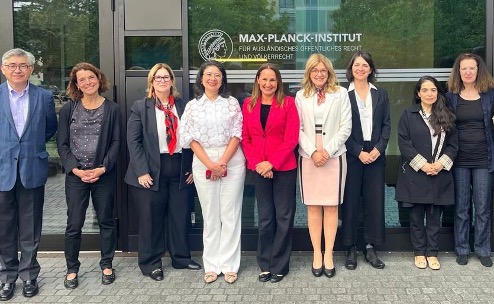
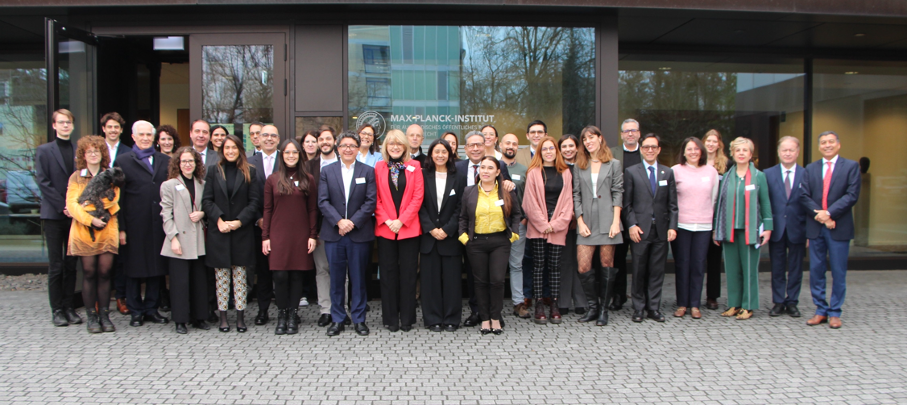

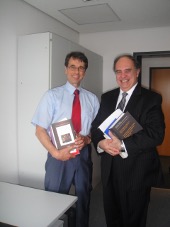









 Mariela Morales Antoniazzi ist seit 2006 als wissenschaftliche Referentin am MPIL, wo sie das Projekt Ius Constitutionale Commune en América Latina (ICCAL) leitet.
Mariela Morales Antoniazzi ist seit 2006 als wissenschaftliche Referentin am MPIL, wo sie das Projekt Ius Constitutionale Commune en América Latina (ICCAL) leitet.
